Quick filters:
Cicero and catiline Stock Photos and Images
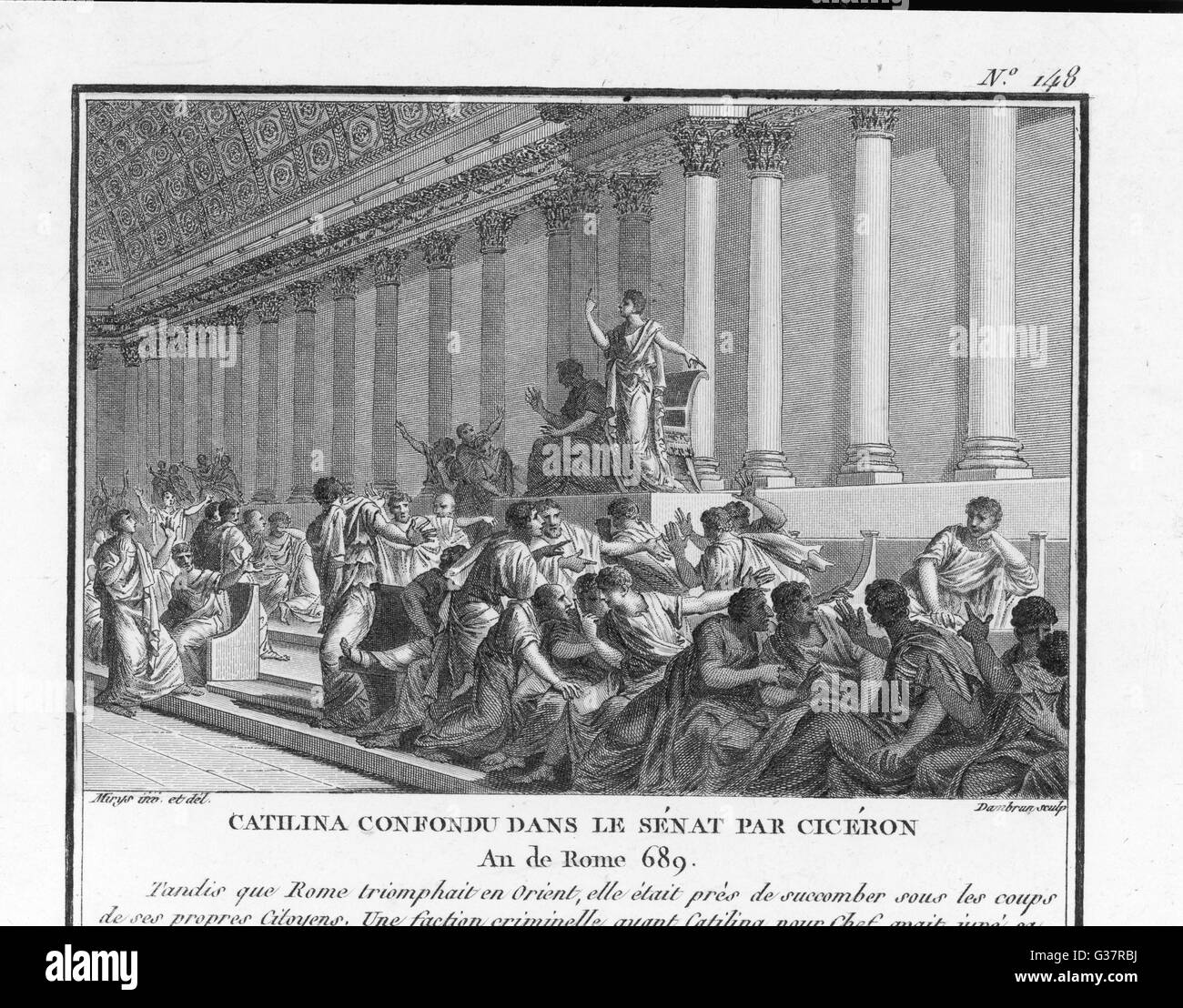 Catiline denounced by Cicero Stock Photohttps://www.alamy.com/image-license-details/?v=1https://www.alamy.com/stock-photo-catiline-denounced-by-cicero-105278198.html
Catiline denounced by Cicero Stock Photohttps://www.alamy.com/image-license-details/?v=1https://www.alamy.com/stock-photo-catiline-denounced-by-cicero-105278198.htmlRMG37RBJ–Catiline denounced by Cicero
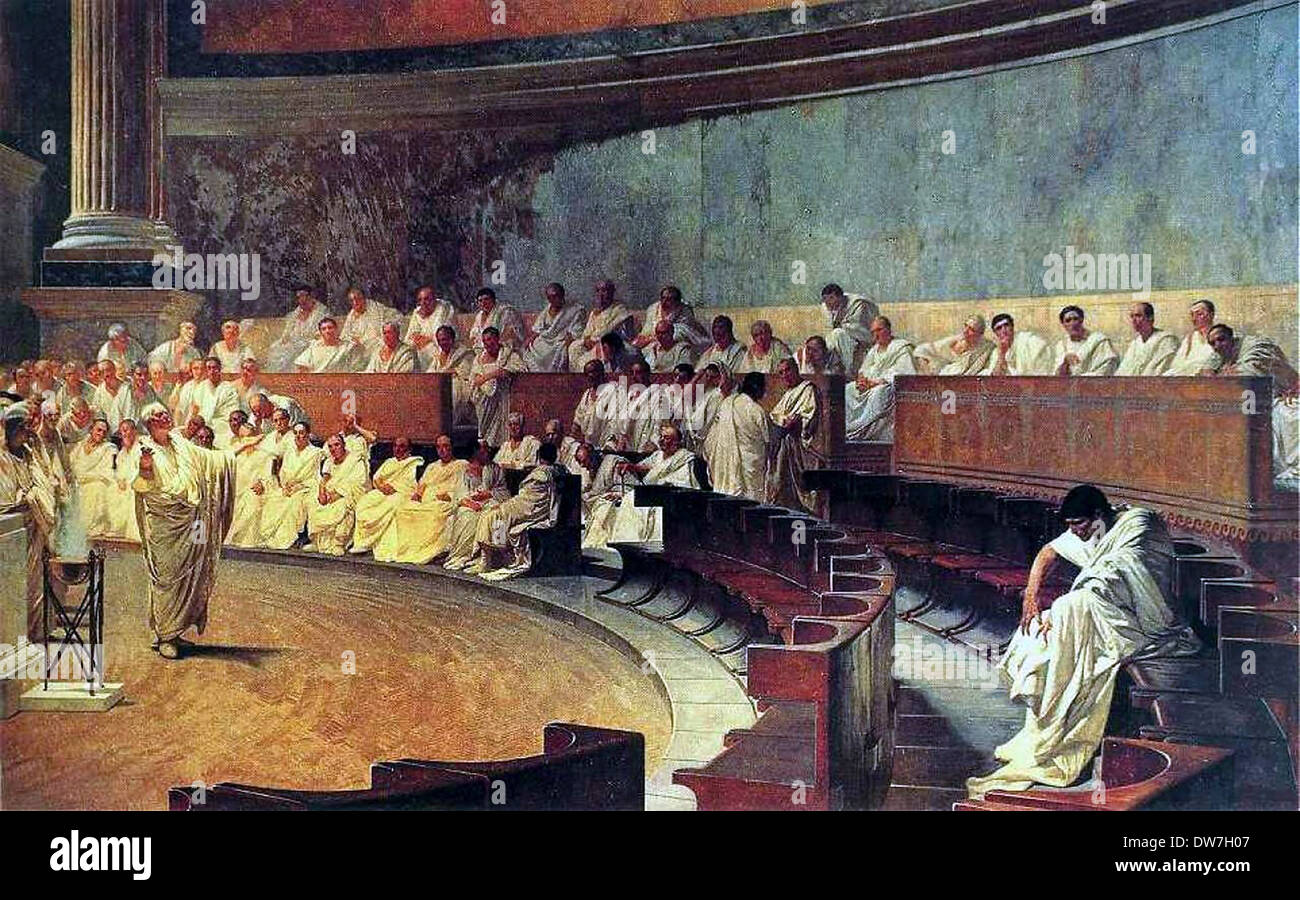 Cicero Denounces Catiline Stock Photohttps://www.alamy.com/image-license-details/?v=1https://www.alamy.com/cicero-denounces-catiline-image67164503.html
Cicero Denounces Catiline Stock Photohttps://www.alamy.com/image-license-details/?v=1https://www.alamy.com/cicero-denounces-catiline-image67164503.htmlRMDW7H07–Cicero Denounces Catiline
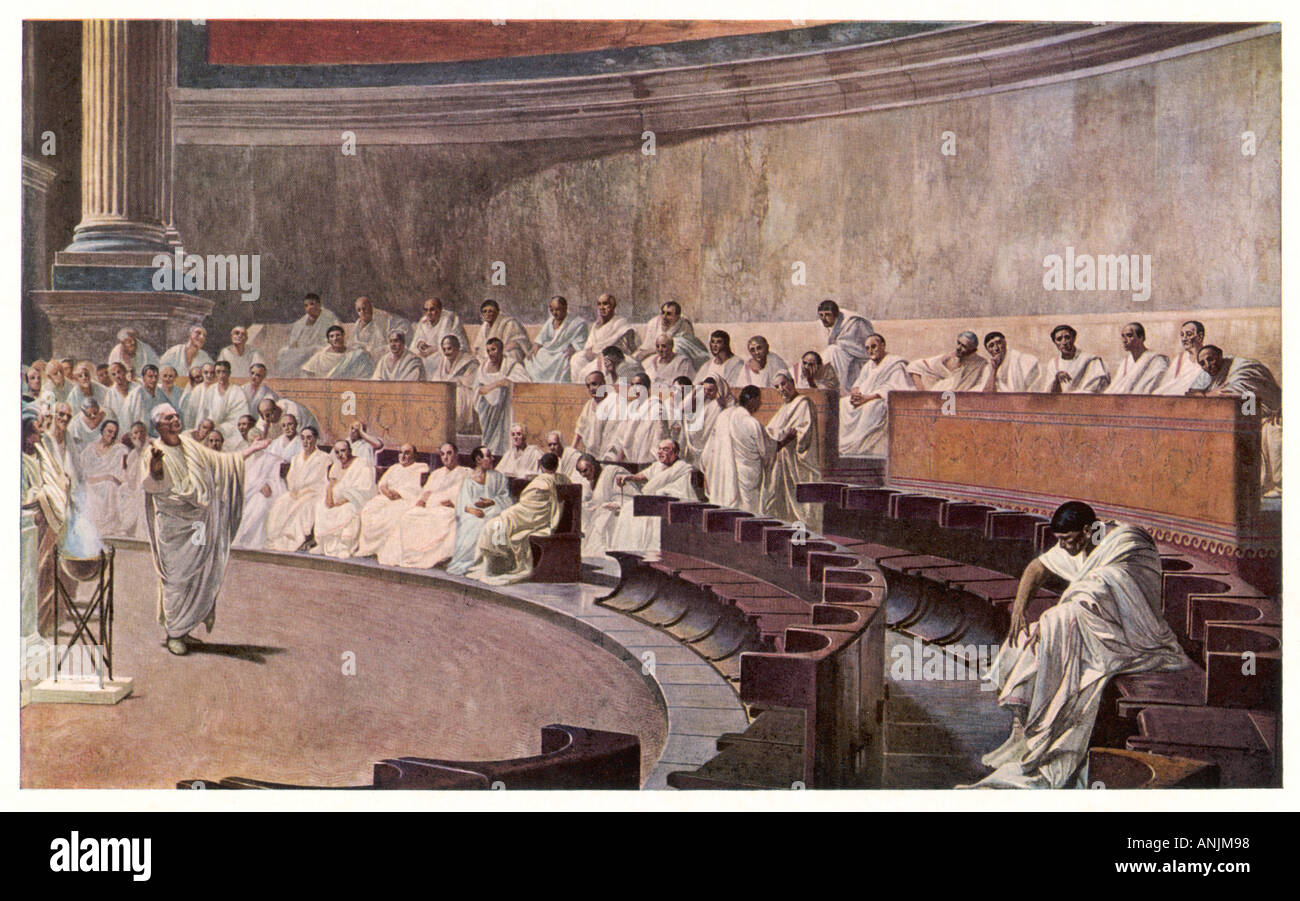 Cicero Speaks In Senate Stock Photohttps://www.alamy.com/image-license-details/?v=1https://www.alamy.com/cicero-speaks-in-senate-image5074071.html
Cicero Speaks In Senate Stock Photohttps://www.alamy.com/image-license-details/?v=1https://www.alamy.com/cicero-speaks-in-senate-image5074071.htmlRMANJM98–Cicero Speaks In Senate
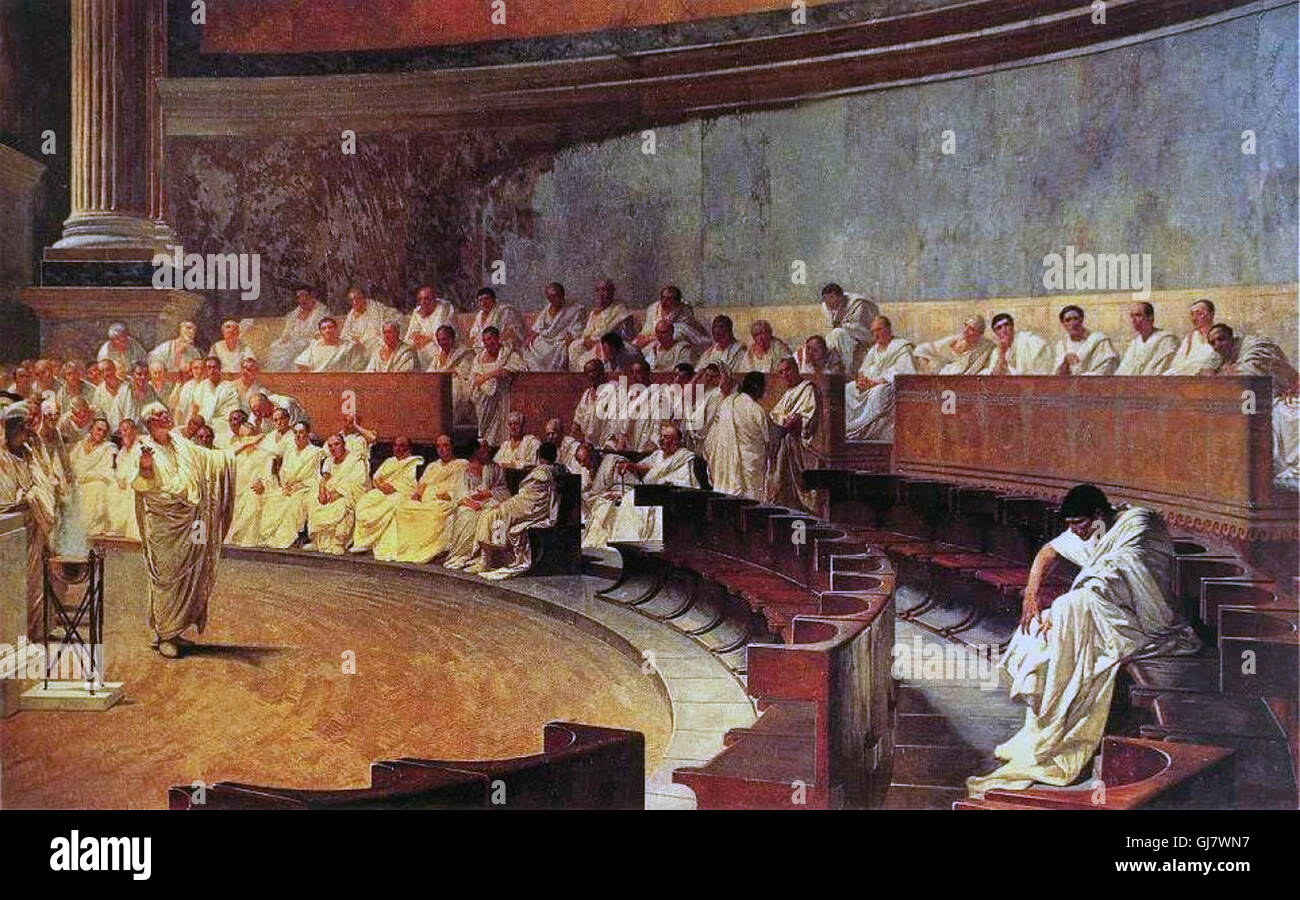 Cicero Denounces Catiline, fresco by Cesare Maccari, 1882–88. Marcus Tullius Cicero was a Roman philosopher, politician, lawyer, orator, political theorist, consul, and constitutionalist. He came from a wealthy municipal family of the Roman equestrian order, and was one of Rome's greatest orators and prose stylists. Stock Photohttps://www.alamy.com/image-license-details/?v=1https://www.alamy.com/stock-photo-cicero-denounces-catiline-fresco-by-cesare-maccari-188288-marcus-tullius-114499875.html
Cicero Denounces Catiline, fresco by Cesare Maccari, 1882–88. Marcus Tullius Cicero was a Roman philosopher, politician, lawyer, orator, political theorist, consul, and constitutionalist. He came from a wealthy municipal family of the Roman equestrian order, and was one of Rome's greatest orators and prose stylists. Stock Photohttps://www.alamy.com/image-license-details/?v=1https://www.alamy.com/stock-photo-cicero-denounces-catiline-fresco-by-cesare-maccari-188288-marcus-tullius-114499875.htmlRMGJ7WN7–Cicero Denounces Catiline, fresco by Cesare Maccari, 1882–88. Marcus Tullius Cicero was a Roman philosopher, politician, lawyer, orator, political theorist, consul, and constitutionalist. He came from a wealthy municipal family of the Roman equestrian order, and was one of Rome's greatest orators and prose stylists.
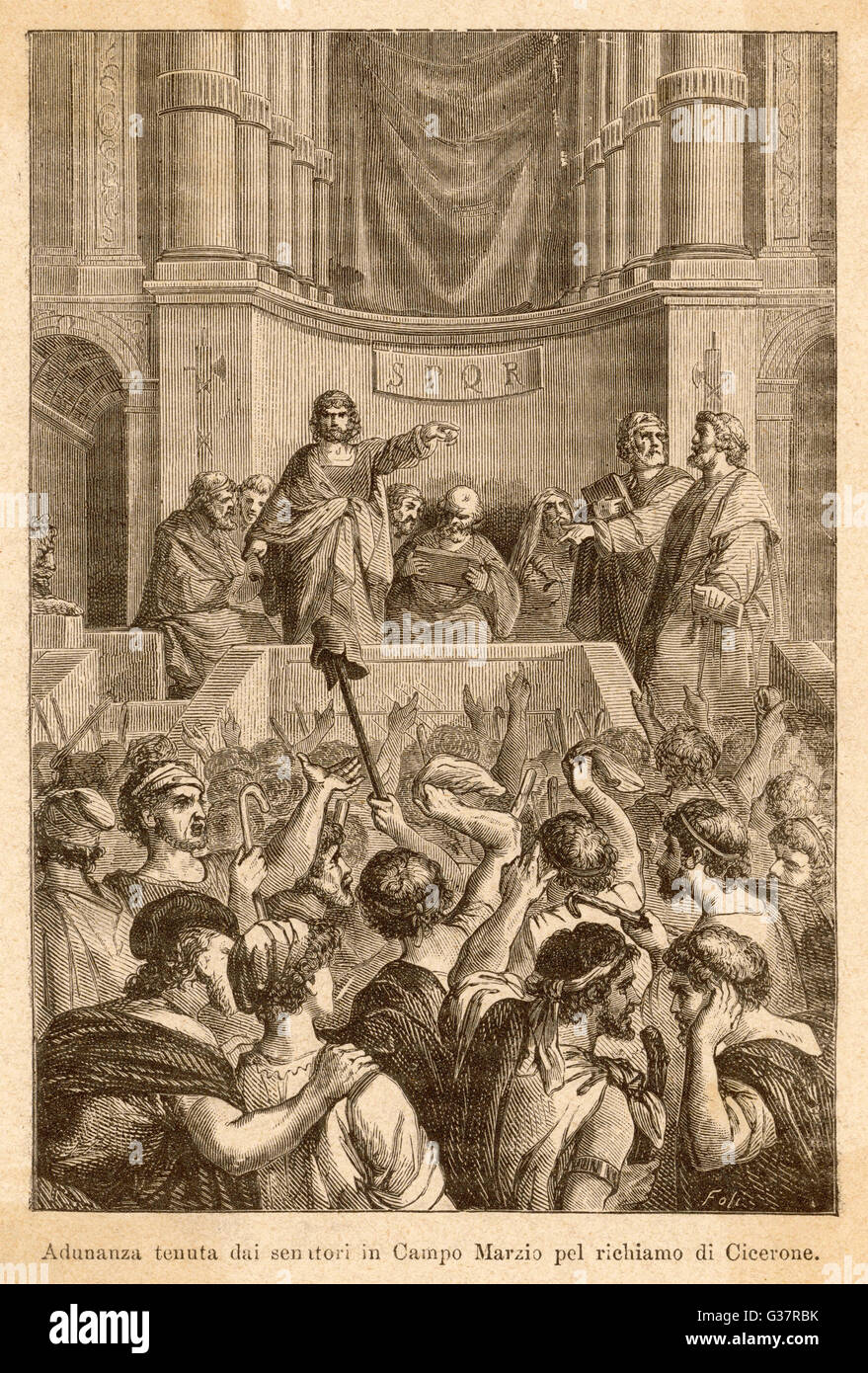 Catiline, plotting to seize power in Rome, is denounced in the Senate by Cicero Date: 63 BC Stock Photohttps://www.alamy.com/image-license-details/?v=1https://www.alamy.com/stock-photo-catiline-plotting-to-seize-power-in-rome-is-denounced-in-the-senate-105278199.html
Catiline, plotting to seize power in Rome, is denounced in the Senate by Cicero Date: 63 BC Stock Photohttps://www.alamy.com/image-license-details/?v=1https://www.alamy.com/stock-photo-catiline-plotting-to-seize-power-in-rome-is-denounced-in-the-senate-105278199.htmlRMG37RBK–Catiline, plotting to seize power in Rome, is denounced in the Senate by Cicero Date: 63 BC
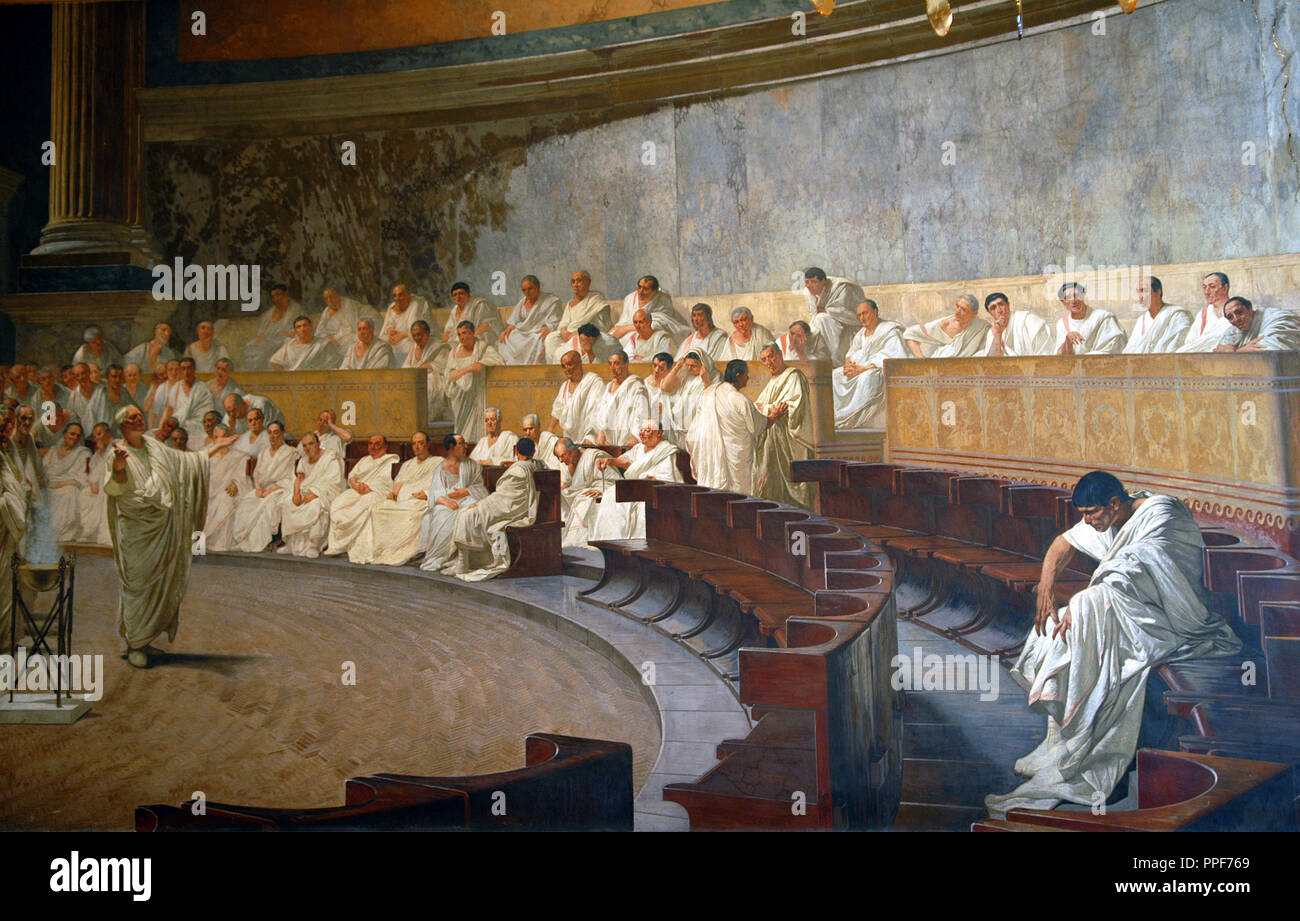 'Cicero in the Roman Senate, accusing Catiline', 1880, Fresco. Author: MACCARI, CESARE. Location: PALACIO MADAMA-SENADO. ITALIA. Stock Photohttps://www.alamy.com/image-license-details/?v=1https://www.alamy.com/cicero-in-the-roman-senate-accusing-catiline-1880-fresco-author-maccari-cesare-location-palacio-madama-senado-italia-image220381793.html
'Cicero in the Roman Senate, accusing Catiline', 1880, Fresco. Author: MACCARI, CESARE. Location: PALACIO MADAMA-SENADO. ITALIA. Stock Photohttps://www.alamy.com/image-license-details/?v=1https://www.alamy.com/cicero-in-the-roman-senate-accusing-catiline-1880-fresco-author-maccari-cesare-location-palacio-madama-senado-italia-image220381793.htmlRMPPF769–'Cicero in the Roman Senate, accusing Catiline', 1880, Fresco. Author: MACCARI, CESARE. Location: PALACIO MADAMA-SENADO. ITALIA.
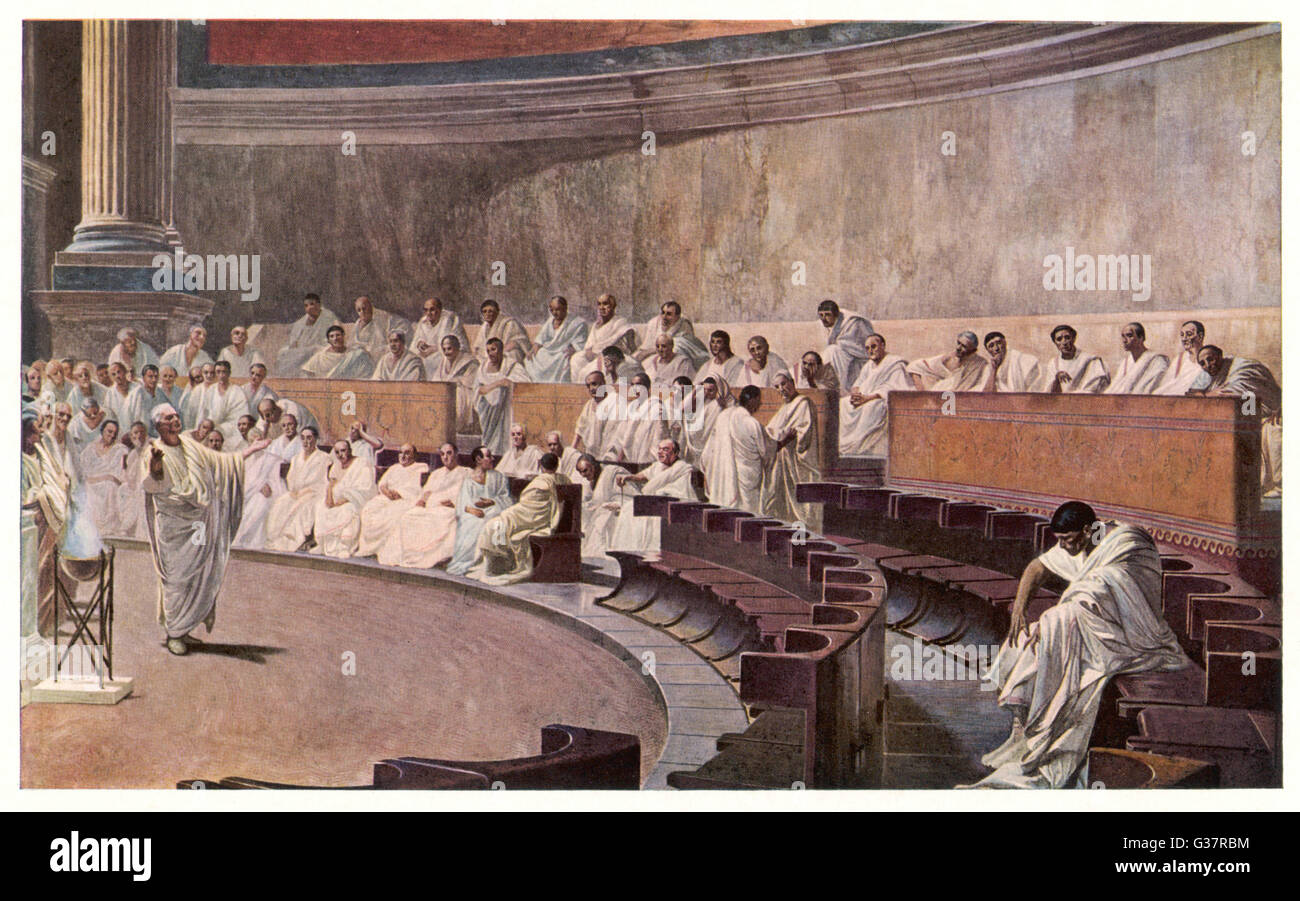 Catiline, plotting to seize power in Rome, is denounced in the Senate by Cicero. As the other senators move away from him, he is left isolated (seated alone to the right of the picture). Date: 63 BC Stock Photohttps://www.alamy.com/image-license-details/?v=1https://www.alamy.com/stock-photo-catiline-plotting-to-seize-power-in-rome-is-denounced-in-the-senate-105278200.html
Catiline, plotting to seize power in Rome, is denounced in the Senate by Cicero. As the other senators move away from him, he is left isolated (seated alone to the right of the picture). Date: 63 BC Stock Photohttps://www.alamy.com/image-license-details/?v=1https://www.alamy.com/stock-photo-catiline-plotting-to-seize-power-in-rome-is-denounced-in-the-senate-105278200.htmlRMG37RBM–Catiline, plotting to seize power in Rome, is denounced in the Senate by Cicero. As the other senators move away from him, he is left isolated (seated alone to the right of the picture). Date: 63 BC
 . Cicero Denounces Catiline 1889 76 Senado Romano Stock Photohttps://www.alamy.com/image-license-details/?v=1https://www.alamy.com/cicero-denounces-catiline-1889-76-senado-romano-image211073488.html
. Cicero Denounces Catiline 1889 76 Senado Romano Stock Photohttps://www.alamy.com/image-license-details/?v=1https://www.alamy.com/cicero-denounces-catiline-1889-76-senado-romano-image211073488.htmlRMP7B6AT–. Cicero Denounces Catiline 1889 76 Senado Romano
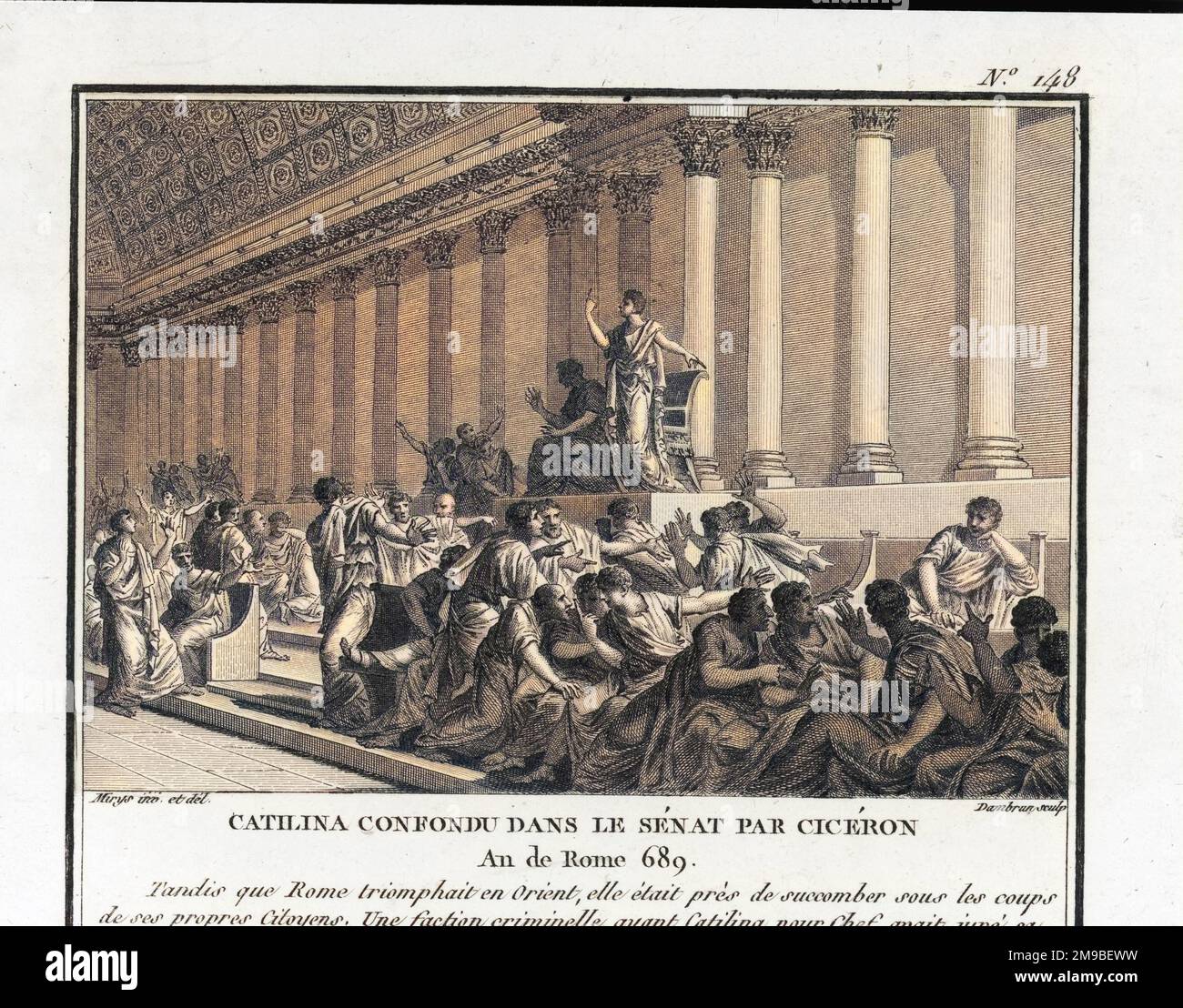 Catiline, plotting to seize power in Rome, is denounced in the Senate by Cicero Stock Photohttps://www.alamy.com/image-license-details/?v=1https://www.alamy.com/catiline-plotting-to-seize-power-in-rome-is-denounced-in-the-senate-by-cicero-image504885749.html
Catiline, plotting to seize power in Rome, is denounced in the Senate by Cicero Stock Photohttps://www.alamy.com/image-license-details/?v=1https://www.alamy.com/catiline-plotting-to-seize-power-in-rome-is-denounced-in-the-senate-by-cicero-image504885749.htmlRM2M9BEWW–Catiline, plotting to seize power in Rome, is denounced in the Senate by Cicero
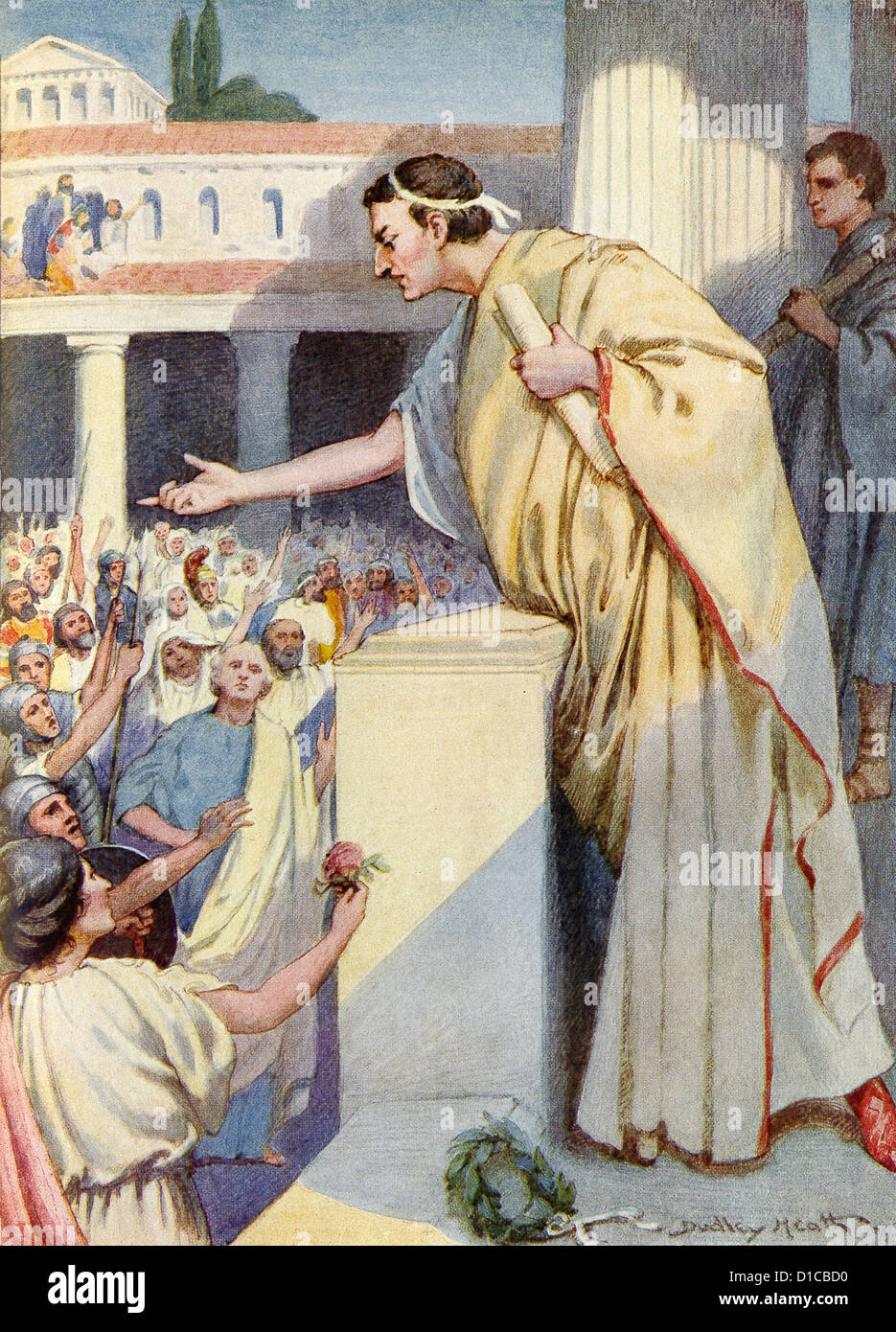 Marcus Tullius Cicero takes his case against the Roman politician/senator Lucius Sergius Catiline to the Roman people. Stock Photohttps://www.alamy.com/image-license-details/?v=1https://www.alamy.com/stock-photo-marcus-tullius-cicero-takes-his-case-against-the-roman-politiciansenator-52518172.html
Marcus Tullius Cicero takes his case against the Roman politician/senator Lucius Sergius Catiline to the Roman people. Stock Photohttps://www.alamy.com/image-license-details/?v=1https://www.alamy.com/stock-photo-marcus-tullius-cicero-takes-his-case-against-the-roman-politiciansenator-52518172.htmlRFD1CBD0–Marcus Tullius Cicero takes his case against the Roman politician/senator Lucius Sergius Catiline to the Roman people.
 'The following morning Cicero made another speech against Catiline', c1912 (1912). Artist: Ernest Dudley Heath. Stock Photohttps://www.alamy.com/image-license-details/?v=1https://www.alamy.com/stock-photo-the-following-morning-cicero-made-another-speech-against-catiline-135296027.html
'The following morning Cicero made another speech against Catiline', c1912 (1912). Artist: Ernest Dudley Heath. Stock Photohttps://www.alamy.com/image-license-details/?v=1https://www.alamy.com/stock-photo-the-following-morning-cicero-made-another-speech-against-catiline-135296027.htmlRMHT37CY–'The following morning Cicero made another speech against Catiline', c1912 (1912). Artist: Ernest Dudley Heath.
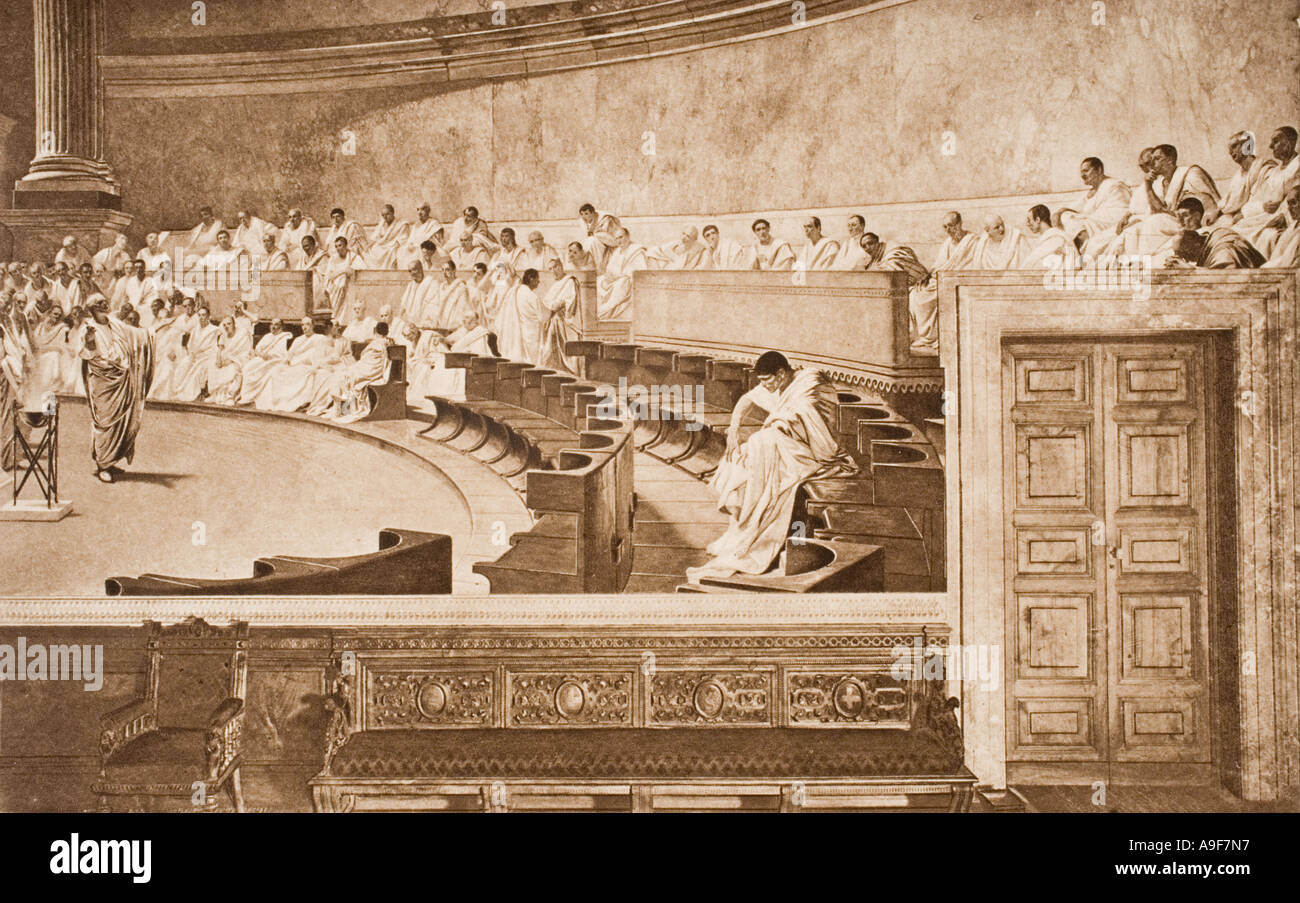 Cicero and Catiline in the Roman Senate Stock Photohttps://www.alamy.com/image-license-details/?v=1https://www.alamy.com/cicero-and-catiline-in-the-roman-senate-image7056534.html
Cicero and Catiline in the Roman Senate Stock Photohttps://www.alamy.com/image-license-details/?v=1https://www.alamy.com/cicero-and-catiline-in-the-roman-senate-image7056534.htmlRMA9F7N7–Cicero and Catiline in the Roman Senate
 Cicero Accuses Catiline Stock Photohttps://www.alamy.com/image-license-details/?v=1https://www.alamy.com/cicero-accuses-catiline-image184244532.html
Cicero Accuses Catiline Stock Photohttps://www.alamy.com/image-license-details/?v=1https://www.alamy.com/cicero-accuses-catiline-image184244532.htmlRMMKN1NT–Cicero Accuses Catiline
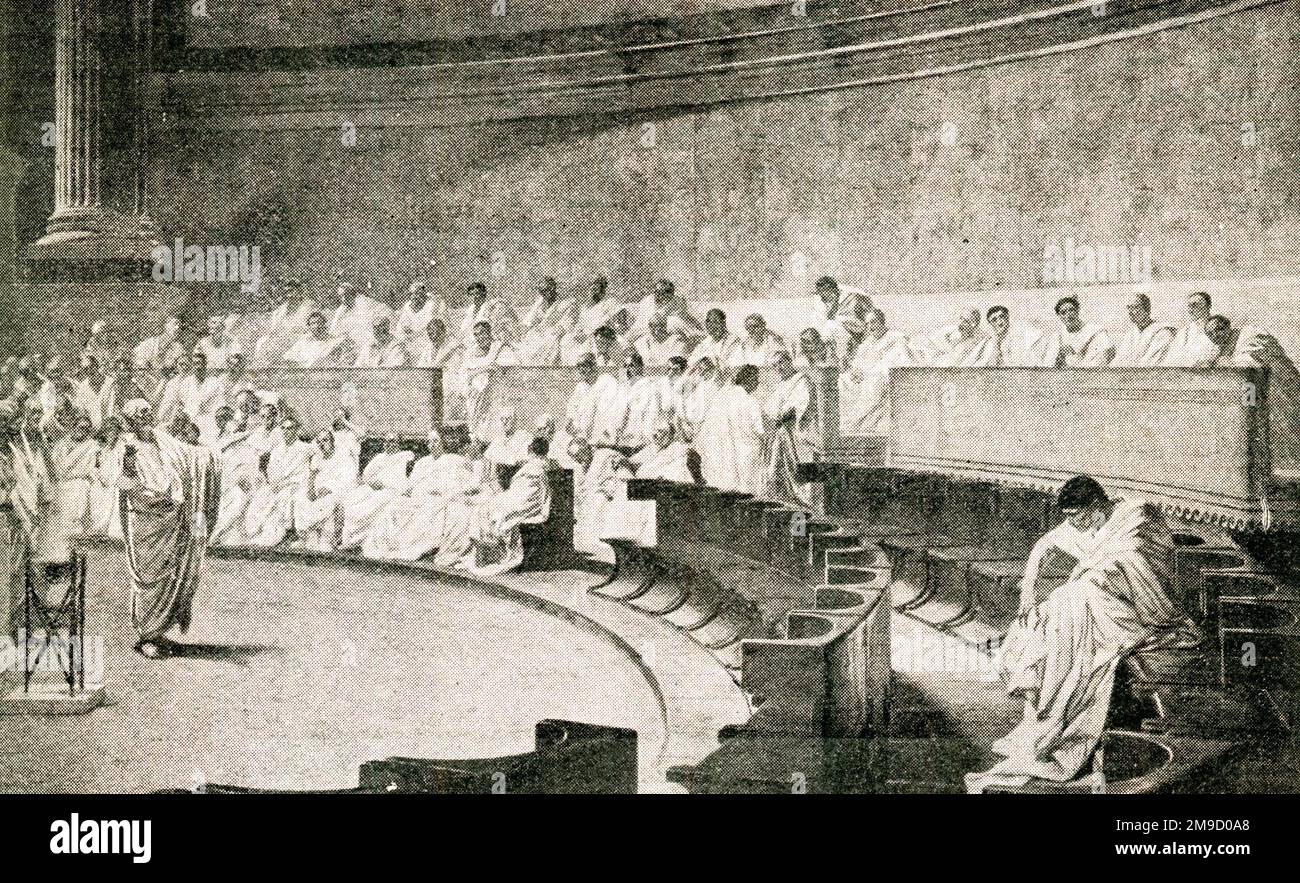 Roman Senate - Cicero Accusing Catiline Of Treason Stock Photohttps://www.alamy.com/image-license-details/?v=1https://www.alamy.com/roman-senate-cicero-accusing-catiline-of-treason-image504918240.html
Roman Senate - Cicero Accusing Catiline Of Treason Stock Photohttps://www.alamy.com/image-license-details/?v=1https://www.alamy.com/roman-senate-cicero-accusing-catiline-of-treason-image504918240.htmlRM2M9D0A8–Roman Senate - Cicero Accusing Catiline Of Treason
 Catiline, plotting to seize power in Rome, is denounced in the Senate by Cicero Colourised version of : 10012798 Date: 63 BC Stock Photohttps://www.alamy.com/image-license-details/?v=1https://www.alamy.com/catiline-plotting-to-seize-power-in-rome-is-denounced-in-the-senate-by-cicero-colourised-version-of-10012798-date-63-bc-image472807712.html
Catiline, plotting to seize power in Rome, is denounced in the Senate by Cicero Colourised version of : 10012798 Date: 63 BC Stock Photohttps://www.alamy.com/image-license-details/?v=1https://www.alamy.com/catiline-plotting-to-seize-power-in-rome-is-denounced-in-the-senate-by-cicero-colourised-version-of-10012798-date-63-bc-image472807712.htmlRM2JD671M–Catiline, plotting to seize power in Rome, is denounced in the Senate by Cicero Colourised version of : 10012798 Date: 63 BC
 Cicero, Catiline Orations, Florence, Plut. 48,22 Stock Photohttps://www.alamy.com/image-license-details/?v=1https://www.alamy.com/stock-photo-cicero-catiline-orations-florence-plut-4822-139722839.html
Cicero, Catiline Orations, Florence, Plut. 48,22 Stock Photohttps://www.alamy.com/image-license-details/?v=1https://www.alamy.com/stock-photo-cicero-catiline-orations-florence-plut-4822-139722839.htmlRMJ38WWB–Cicero, Catiline Orations, Florence, Plut. 48,22
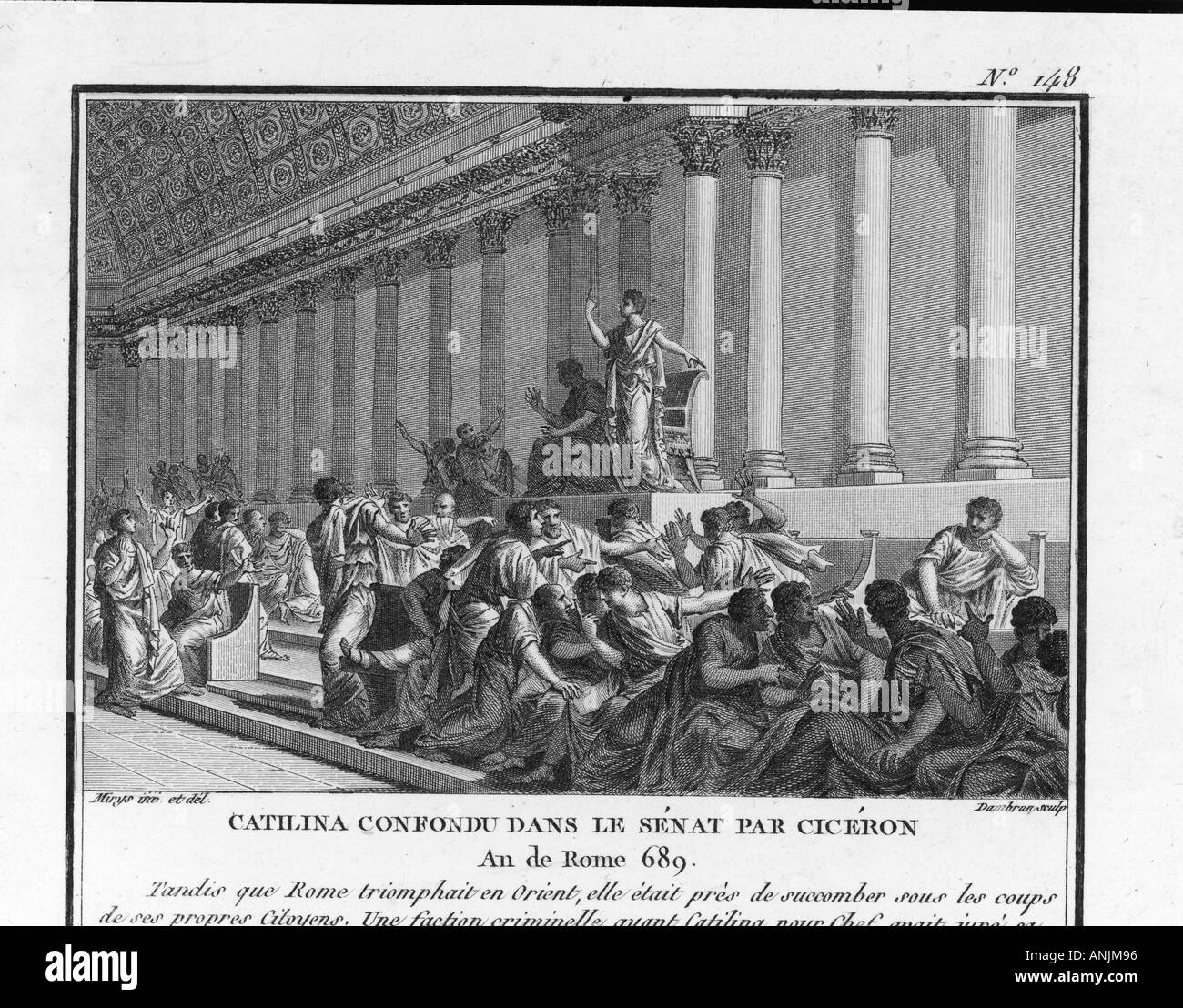 Catiline Denounced By Cicero Stock Photohttps://www.alamy.com/image-license-details/?v=1https://www.alamy.com/catiline-denounced-by-cicero-image5074069.html
Catiline Denounced By Cicero Stock Photohttps://www.alamy.com/image-license-details/?v=1https://www.alamy.com/catiline-denounced-by-cicero-image5074069.htmlRMANJM96–Catiline Denounced By Cicero
 Cicero, Catiline Orations, Florence, Plut. 48,22. Stock Photohttps://www.alamy.com/image-license-details/?v=1https://www.alamy.com/cicero-catiline-orations-florence-plut-4822-image260369830.html
Cicero, Catiline Orations, Florence, Plut. 48,22. Stock Photohttps://www.alamy.com/image-license-details/?v=1https://www.alamy.com/cicero-catiline-orations-florence-plut-4822-image260369830.htmlRMW3GTAE–Cicero, Catiline Orations, Florence, Plut. 48,22.
 Cicero, Catiline Orations, Florence, Plut. 48,22 Stock Photohttps://www.alamy.com/image-license-details/?v=1https://www.alamy.com/stock-photo-cicero-catiline-orations-florence-plut-4822-132508381.html
Cicero, Catiline Orations, Florence, Plut. 48,22 Stock Photohttps://www.alamy.com/image-license-details/?v=1https://www.alamy.com/stock-photo-cicero-catiline-orations-florence-plut-4822-132508381.htmlRMHKG7P5–Cicero, Catiline Orations, Florence, Plut. 48,22
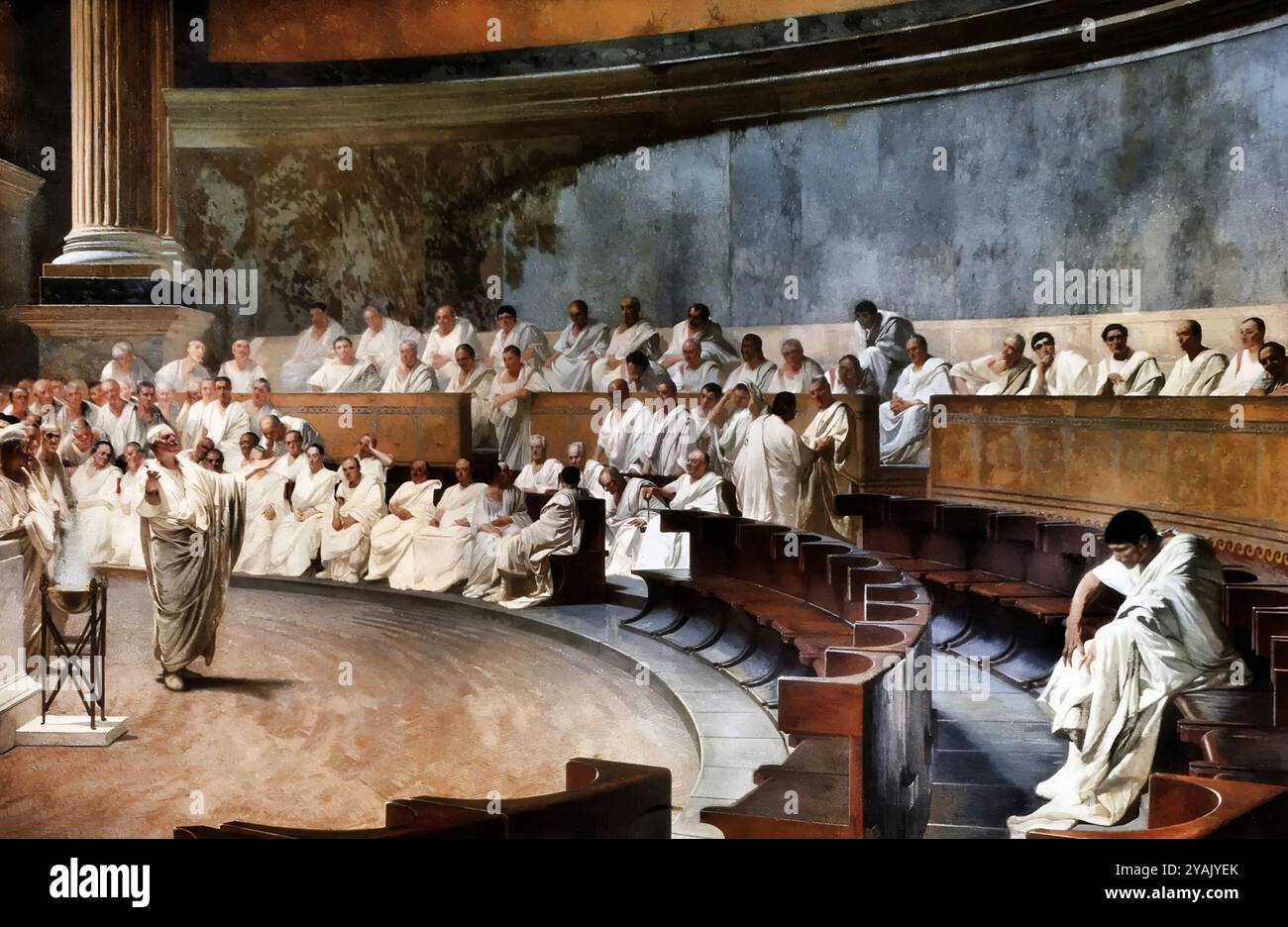 Cesare Maccari. Painting entitled Cicero Denounces Catiline in the Roman Senate by the Italian painter and sculptor, Cesare Maccari (1840-1919), fresco in the Palazzo Madama, Rome, 1889 Stock Photohttps://www.alamy.com/image-license-details/?v=1https://www.alamy.com/cesare-maccari-painting-entitled-cicero-denounces-catiline-in-the-roman-senate-by-the-italian-painter-and-sculptor-cesare-maccari-1840-1919-fresco-in-the-palazzo-madama-rome-1889-image626136523.html
Cesare Maccari. Painting entitled Cicero Denounces Catiline in the Roman Senate by the Italian painter and sculptor, Cesare Maccari (1840-1919), fresco in the Palazzo Madama, Rome, 1889 Stock Photohttps://www.alamy.com/image-license-details/?v=1https://www.alamy.com/cesare-maccari-painting-entitled-cicero-denounces-catiline-in-the-roman-senate-by-the-italian-painter-and-sculptor-cesare-maccari-1840-1919-fresco-in-the-palazzo-madama-rome-1889-image626136523.htmlRM2YAJYEK–Cesare Maccari. Painting entitled Cicero Denounces Catiline in the Roman Senate by the Italian painter and sculptor, Cesare Maccari (1840-1919), fresco in the Palazzo Madama, Rome, 1889
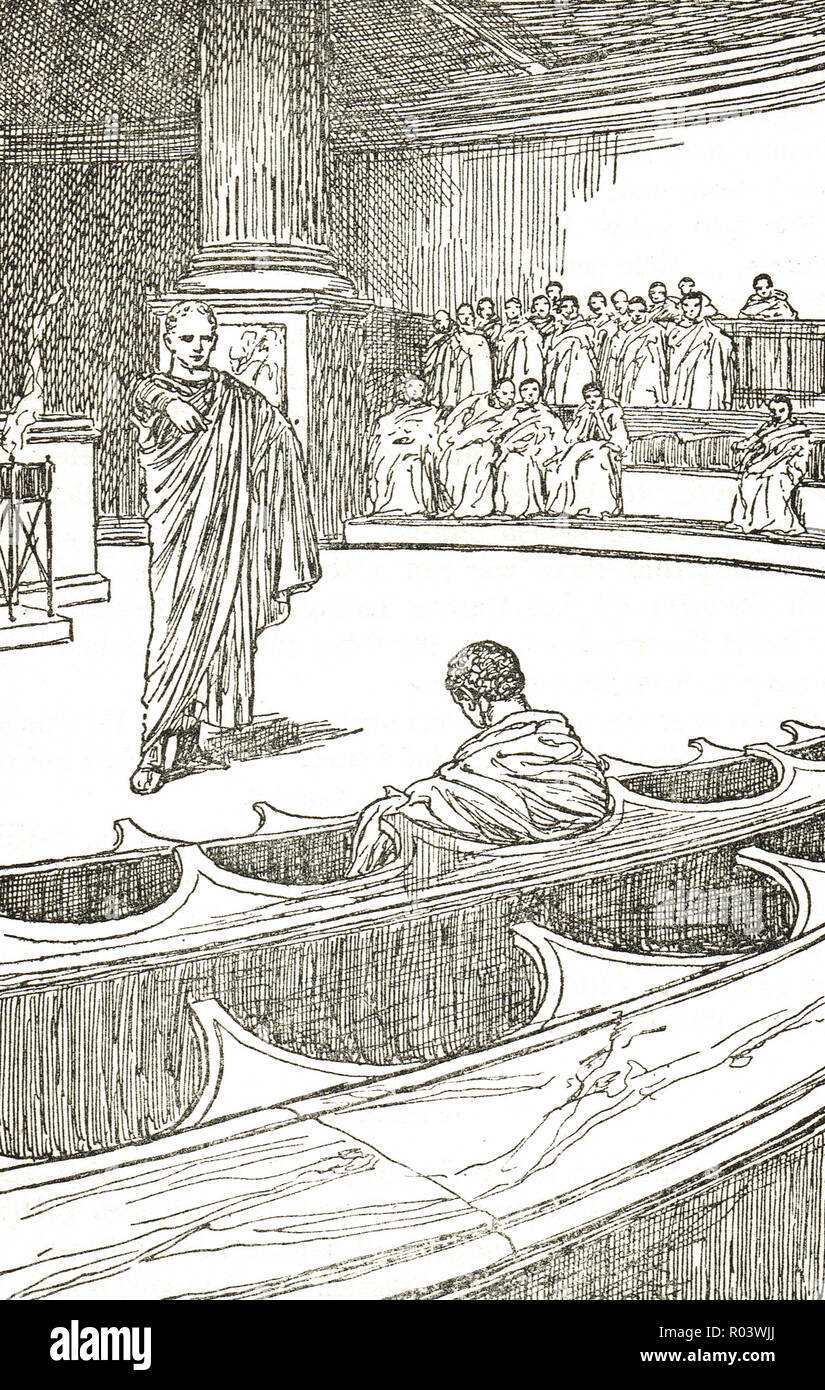 Marcus Tullius Cicero denouncing Lucius Sergius Catilina. The Cataline conspiracy to overthrow the Roman Republic in 63 BC Stock Photohttps://www.alamy.com/image-license-details/?v=1https://www.alamy.com/marcus-tullius-cicero-denouncing-lucius-sergius-catilina-the-cataline-conspiracy-to-overthrow-the-roman-republic-in-63-bc-image223820762.html
Marcus Tullius Cicero denouncing Lucius Sergius Catilina. The Cataline conspiracy to overthrow the Roman Republic in 63 BC Stock Photohttps://www.alamy.com/image-license-details/?v=1https://www.alamy.com/marcus-tullius-cicero-denouncing-lucius-sergius-catilina-the-cataline-conspiracy-to-overthrow-the-roman-republic-in-63-bc-image223820762.htmlRMR03WJJ–Marcus Tullius Cicero denouncing Lucius Sergius Catilina. The Cataline conspiracy to overthrow the Roman Republic in 63 BC
 ROMAN SENATE in session on a 19th century fresco in the Palazzo Madama,Rome. It shows Cicero attacking Catiline Stock Photohttps://www.alamy.com/image-license-details/?v=1https://www.alamy.com/roman-senate-in-session-on-a-19th-century-fresco-in-the-palazzo-madamarome-it-shows-cicero-attacking-catiline-image524592350.html
ROMAN SENATE in session on a 19th century fresco in the Palazzo Madama,Rome. It shows Cicero attacking Catiline Stock Photohttps://www.alamy.com/image-license-details/?v=1https://www.alamy.com/roman-senate-in-session-on-a-19th-century-fresco-in-the-palazzo-madamarome-it-shows-cicero-attacking-catiline-image524592350.htmlRM2NDD6W2–ROMAN SENATE in session on a 19th century fresco in the Palazzo Madama,Rome. It shows Cicero attacking Catiline
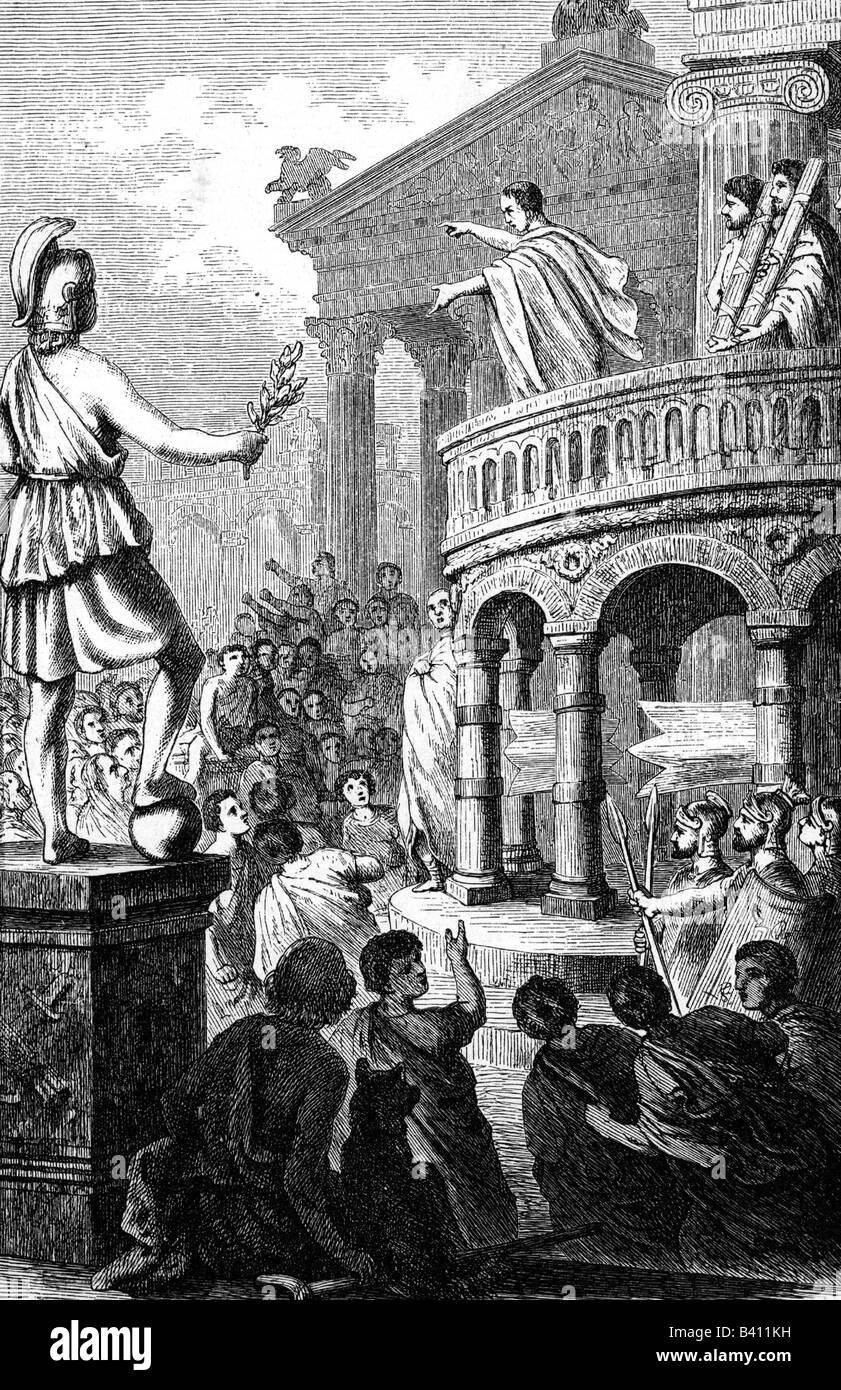 Cicero, Marcus Tullius, 3.1.106 - 7.12.43 BC, Roman politician, author, full length, during his speach against Catiline on rostra in Rome, Italy, fantasy drawing by H. Leutemann, 19th century, Stock Photohttps://www.alamy.com/image-license-details/?v=1https://www.alamy.com/stock-photo-cicero-marcus-tullius-31106-71243-bc-roman-politician-author-full-19692277.html
Cicero, Marcus Tullius, 3.1.106 - 7.12.43 BC, Roman politician, author, full length, during his speach against Catiline on rostra in Rome, Italy, fantasy drawing by H. Leutemann, 19th century, Stock Photohttps://www.alamy.com/image-license-details/?v=1https://www.alamy.com/stock-photo-cicero-marcus-tullius-31106-71243-bc-roman-politician-author-full-19692277.htmlRMB411KH–Cicero, Marcus Tullius, 3.1.106 - 7.12.43 BC, Roman politician, author, full length, during his speach against Catiline on rostra in Rome, Italy, fantasy drawing by H. Leutemann, 19th century,
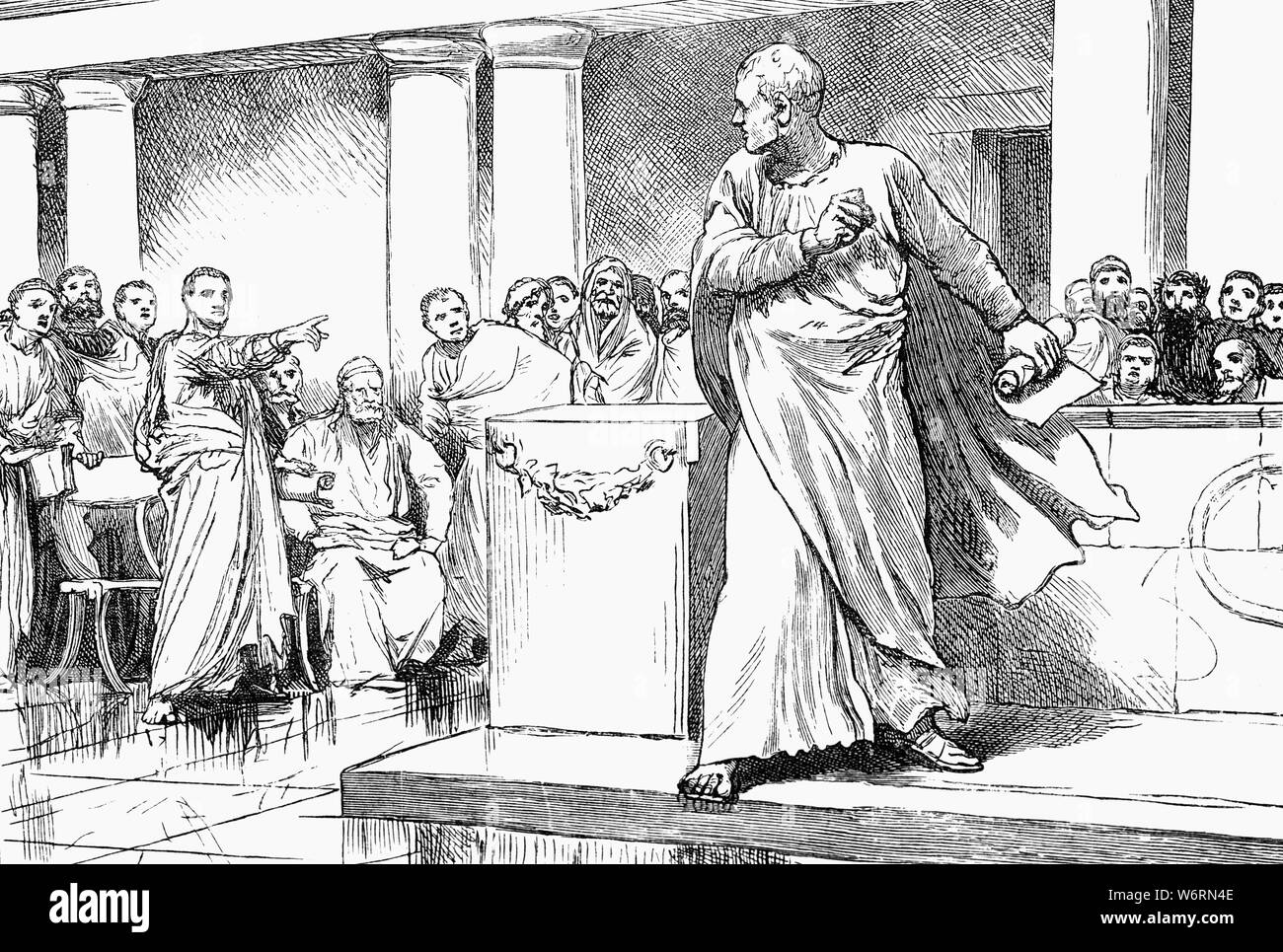 Lucius Sergius Catilina, known in English as Catiline(108–62 BCE), was a Roman Senator of the 1st century BC best known for the second Catilinarian conspiracy, a plot, devised by Catiline with the help of a group of aristocrats and disaffected veterans, to overthrow the Roman Republic in 63 BC. Cicero exposed the plot, which forced Catiline to flee from Rome. Stock Photohttps://www.alamy.com/image-license-details/?v=1https://www.alamy.com/lucius-sergius-catilina-known-in-english-as-catiline10862-bce-was-a-roman-senator-of-the-1st-century-bc-best-known-for-the-second-catilinarian-conspiracy-a-plot-devised-by-catiline-with-the-help-of-a-group-of-aristocrats-and-disaffected-veterans-to-overthrow-the-roman-republic-in-63-bc-cicero-exposed-the-plot-which-forced-catiline-to-flee-from-rome-image262364942.html
Lucius Sergius Catilina, known in English as Catiline(108–62 BCE), was a Roman Senator of the 1st century BC best known for the second Catilinarian conspiracy, a plot, devised by Catiline with the help of a group of aristocrats and disaffected veterans, to overthrow the Roman Republic in 63 BC. Cicero exposed the plot, which forced Catiline to flee from Rome. Stock Photohttps://www.alamy.com/image-license-details/?v=1https://www.alamy.com/lucius-sergius-catilina-known-in-english-as-catiline10862-bce-was-a-roman-senator-of-the-1st-century-bc-best-known-for-the-second-catilinarian-conspiracy-a-plot-devised-by-catiline-with-the-help-of-a-group-of-aristocrats-and-disaffected-veterans-to-overthrow-the-roman-republic-in-63-bc-cicero-exposed-the-plot-which-forced-catiline-to-flee-from-rome-image262364942.htmlRMW6RN4E–Lucius Sergius Catilina, known in English as Catiline(108–62 BCE), was a Roman Senator of the 1st century BC best known for the second Catilinarian conspiracy, a plot, devised by Catiline with the help of a group of aristocrats and disaffected veterans, to overthrow the Roman Republic in 63 BC. Cicero exposed the plot, which forced Catiline to flee from Rome.
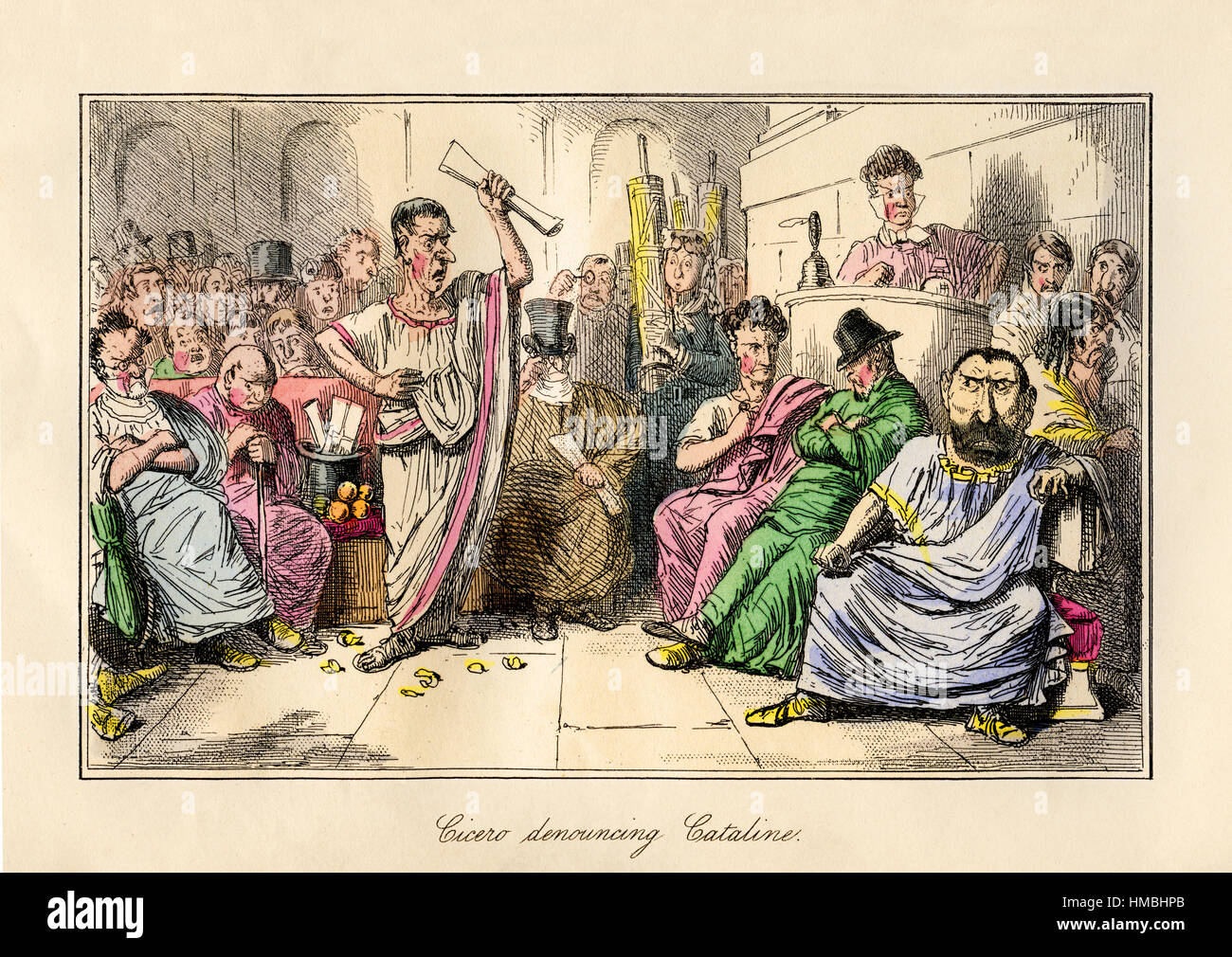 Cicero denouncing Cataline. From 'The Comic History of Rome' by Gilbert à Beckett. Illustrated by John Leech published in 1864. Stock Photohttps://www.alamy.com/image-license-details/?v=1https://www.alamy.com/stock-photo-cicero-denouncing-cataline-from-the-comic-history-of-rome-by-gilbert-133021123.html
Cicero denouncing Cataline. From 'The Comic History of Rome' by Gilbert à Beckett. Illustrated by John Leech published in 1864. Stock Photohttps://www.alamy.com/image-license-details/?v=1https://www.alamy.com/stock-photo-cicero-denouncing-cataline-from-the-comic-history-of-rome-by-gilbert-133021123.htmlRMHMBHPB–Cicero denouncing Cataline. From 'The Comic History of Rome' by Gilbert à Beckett. Illustrated by John Leech published in 1864.
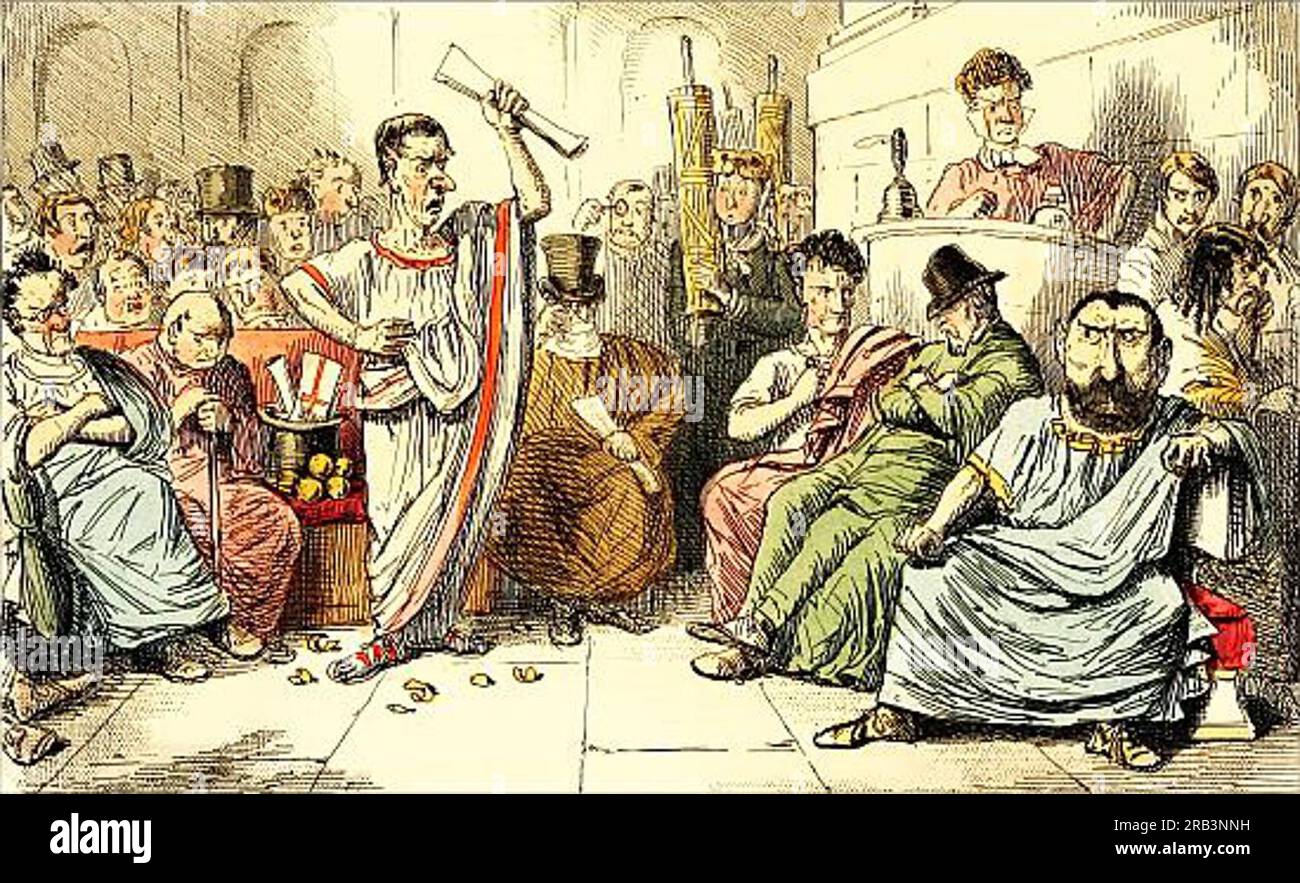 Cicero denouncing Catiline by John Leech Stock Photohttps://www.alamy.com/image-license-details/?v=1https://www.alamy.com/cicero-denouncing-catiline-by-john-leech-image557575917.html
Cicero denouncing Catiline by John Leech Stock Photohttps://www.alamy.com/image-license-details/?v=1https://www.alamy.com/cicero-denouncing-catiline-by-john-leech-image557575917.htmlRM2RB3NNH–Cicero denouncing Catiline by John Leech
 . English: Cicero, end of the 4th Catiliniarian Oration, in a manuscript written by Poggio Bracciolini. Florence, Biblioteca Medicea Laurenziana, Plut. 48,22, fol. 121r. Deutsch: Cicero, Ende der vierten Catilinarischen Rede, in einer von Poggio Bracciolini geschriebenen Handschrift. Florenz, Biblioteca Medicea Laurenziana, Plut. 48,22, fol. 121r. 1425. Cicero 131 Cicero, Catiline Orations, Florence, Plut. 48,22 Stock Photohttps://www.alamy.com/image-license-details/?v=1https://www.alamy.com/english-cicero-end-of-the-4th-catiliniarian-oration-in-a-manuscript-written-by-poggio-bracciolini-florence-biblioteca-medicea-laurenziana-plut-4822-fol-121r-deutsch-cicero-ende-der-vierten-catilinarischen-rede-in-einer-von-poggio-bracciolini-geschriebenen-handschrift-florenz-biblioteca-medicea-laurenziana-plut-4822-fol-121r-1425-cicero-131-cicero-catiline-orations-florence-plut-4822-image188121724.html
. English: Cicero, end of the 4th Catiliniarian Oration, in a manuscript written by Poggio Bracciolini. Florence, Biblioteca Medicea Laurenziana, Plut. 48,22, fol. 121r. Deutsch: Cicero, Ende der vierten Catilinarischen Rede, in einer von Poggio Bracciolini geschriebenen Handschrift. Florenz, Biblioteca Medicea Laurenziana, Plut. 48,22, fol. 121r. 1425. Cicero 131 Cicero, Catiline Orations, Florence, Plut. 48,22 Stock Photohttps://www.alamy.com/image-license-details/?v=1https://www.alamy.com/english-cicero-end-of-the-4th-catiliniarian-oration-in-a-manuscript-written-by-poggio-bracciolini-florence-biblioteca-medicea-laurenziana-plut-4822-fol-121r-deutsch-cicero-ende-der-vierten-catilinarischen-rede-in-einer-von-poggio-bracciolini-geschriebenen-handschrift-florenz-biblioteca-medicea-laurenziana-plut-4822-fol-121r-1425-cicero-131-cicero-catiline-orations-florence-plut-4822-image188121724.htmlRMMX1K50–. English: Cicero, end of the 4th Catiliniarian Oration, in a manuscript written by Poggio Bracciolini. Florence, Biblioteca Medicea Laurenziana, Plut. 48,22, fol. 121r. Deutsch: Cicero, Ende der vierten Catilinarischen Rede, in einer von Poggio Bracciolini geschriebenen Handschrift. Florenz, Biblioteca Medicea Laurenziana, Plut. 48,22, fol. 121r. 1425. Cicero 131 Cicero, Catiline Orations, Florence, Plut. 48,22
 'The following morning Cicero made another speech against Catiline', c1912 (1912). Artist: Ernest Dudley Heath. Stock Photohttps://www.alamy.com/image-license-details/?v=1https://www.alamy.com/the-following-morning-cicero-made-another-speech-against-catiline-c1912-1912-artist-ernest-dudley-heath-image262787086.html
'The following morning Cicero made another speech against Catiline', c1912 (1912). Artist: Ernest Dudley Heath. Stock Photohttps://www.alamy.com/image-license-details/?v=1https://www.alamy.com/the-following-morning-cicero-made-another-speech-against-catiline-c1912-1912-artist-ernest-dudley-heath-image262787086.htmlRMW7EYH2–'The following morning Cicero made another speech against Catiline', c1912 (1912). Artist: Ernest Dudley Heath.
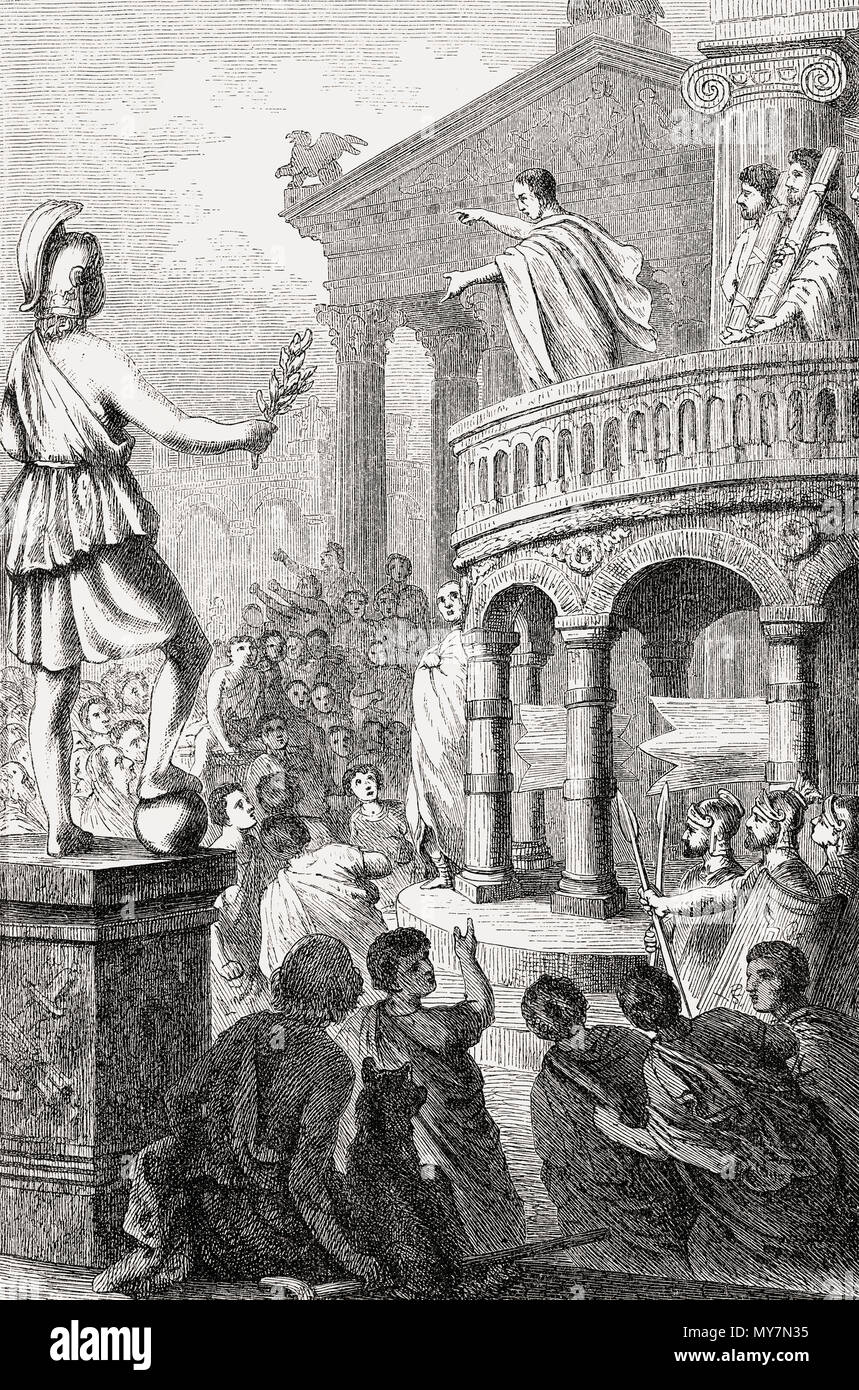 The Catiline or Catilinarian Orations, speeches to the Roman Senate given by Marcus Tullius Cicero in 63 BC Stock Photohttps://www.alamy.com/image-license-details/?v=1https://www.alamy.com/the-catiline-or-catilinarian-orations-speeches-to-the-roman-senate-given-by-marcus-tullius-cicero-in-63-bc-image188869609.html
The Catiline or Catilinarian Orations, speeches to the Roman Senate given by Marcus Tullius Cicero in 63 BC Stock Photohttps://www.alamy.com/image-license-details/?v=1https://www.alamy.com/the-catiline-or-catilinarian-orations-speeches-to-the-roman-senate-given-by-marcus-tullius-cicero-in-63-bc-image188869609.htmlRMMY7N35–The Catiline or Catilinarian Orations, speeches to the Roman Senate given by Marcus Tullius Cicero in 63 BC
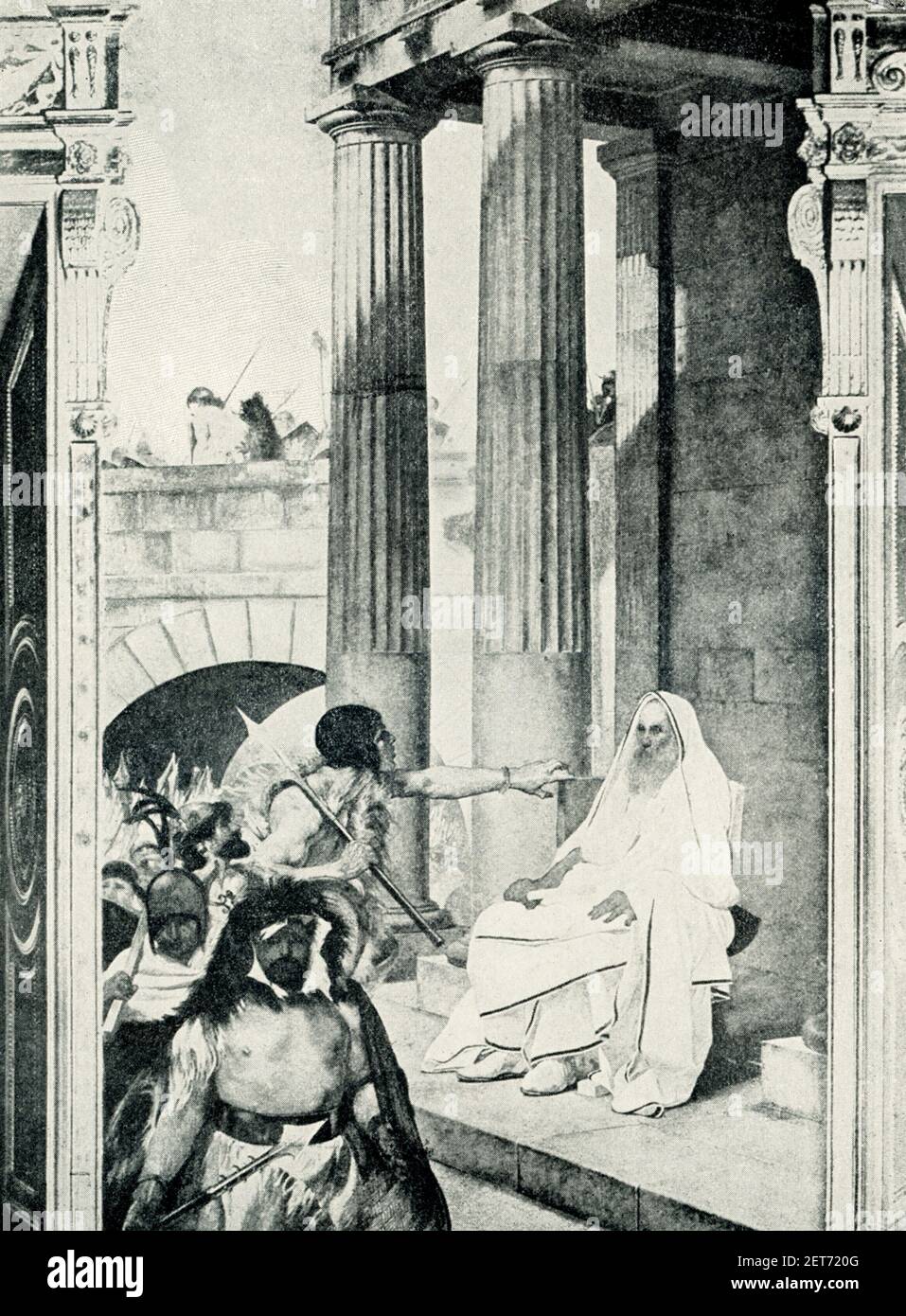 This image shows Papirius insulted by the Gauls as drawn by C Maccari. According to the Roman tale, in the 380s B.C., the Gauls invaded Italy and Rome itself. When they entered Rome, the senators refused to flee. The actual details vary, but here the senators are shown in the Senate house. When the Gauls touch the beard of the Senator Papirius, Papirius no longer remains unmoving - rather he hits back. Slaughter ensues. Cesare Maccari (1840 –1919) was an Italian painter and sculptor, most famous for his 1888 painting showing Cicero Denouncing Catiline. Stock Photohttps://www.alamy.com/image-license-details/?v=1https://www.alamy.com/this-image-shows-papirius-insulted-by-the-gauls-as-drawn-by-c-maccari-according-to-the-roman-tale-in-the-380s-bc-the-gauls-invaded-italy-and-rome-itself-when-they-entered-rome-the-senators-refused-to-flee-the-actual-details-vary-but-here-the-senators-are-shown-in-the-senate-house-when-the-gauls-touch-the-beard-of-the-senator-papirius-papirius-no-longer-remains-unmoving-rather-he-hits-back-slaughter-ensues-cesaremaccari1840-1919-was-an-italianpainterand-sculptor-most-famous-for-his-1888paintingshowing-cicero-denouncing-catiline-image410745456.html
This image shows Papirius insulted by the Gauls as drawn by C Maccari. According to the Roman tale, in the 380s B.C., the Gauls invaded Italy and Rome itself. When they entered Rome, the senators refused to flee. The actual details vary, but here the senators are shown in the Senate house. When the Gauls touch the beard of the Senator Papirius, Papirius no longer remains unmoving - rather he hits back. Slaughter ensues. Cesare Maccari (1840 –1919) was an Italian painter and sculptor, most famous for his 1888 painting showing Cicero Denouncing Catiline. Stock Photohttps://www.alamy.com/image-license-details/?v=1https://www.alamy.com/this-image-shows-papirius-insulted-by-the-gauls-as-drawn-by-c-maccari-according-to-the-roman-tale-in-the-380s-bc-the-gauls-invaded-italy-and-rome-itself-when-they-entered-rome-the-senators-refused-to-flee-the-actual-details-vary-but-here-the-senators-are-shown-in-the-senate-house-when-the-gauls-touch-the-beard-of-the-senator-papirius-papirius-no-longer-remains-unmoving-rather-he-hits-back-slaughter-ensues-cesaremaccari1840-1919-was-an-italianpainterand-sculptor-most-famous-for-his-1888paintingshowing-cicero-denouncing-catiline-image410745456.htmlRF2ET720G–This image shows Papirius insulted by the Gauls as drawn by C Maccari. According to the Roman tale, in the 380s B.C., the Gauls invaded Italy and Rome itself. When they entered Rome, the senators refused to flee. The actual details vary, but here the senators are shown in the Senate house. When the Gauls touch the beard of the Senator Papirius, Papirius no longer remains unmoving - rather he hits back. Slaughter ensues. Cesare Maccari (1840 –1919) was an Italian painter and sculptor, most famous for his 1888 painting showing Cicero Denouncing Catiline.
 Ponte Molle - Rome, 1850. 'Outside the city walls, to the north, and about two miles up the Tiber, the stream is crossed by the famous Ponte Molle, the ancient Pons Milvius, so celebrated in Roman story. Here it was that Cicero caused to be arrested, according to a preconcerted scheme, the Allobrogian ambassadors, who were implicated in the conspiracy of Catiline; and it was at the Pons Milvius that Constantine the Great, hoisting the Christian standard or Labarum, completely routed the forces of his opponent Maxentius. The piers and arches are all that remain of the ancient structure, the bat Stock Photohttps://www.alamy.com/image-license-details/?v=1https://www.alamy.com/ponte-molle-rome-1850-outside-the-city-walls-to-the-north-and-about-two-miles-up-the-tiber-the-stream-is-crossed-by-the-famous-ponte-molle-the-ancient-pons-milvius-so-celebrated-in-roman-story-here-it-was-that-cicero-caused-to-be-arrested-according-to-a-preconcerted-scheme-the-allobrogian-ambassadors-who-were-implicated-in-the-conspiracy-of-catiline-and-it-was-at-the-pons-milvius-that-constantine-the-great-hoisting-the-christian-standard-or-labarum-completely-routed-the-forces-of-his-opponent-maxentius-the-piers-and-arches-are-all-that-remain-of-the-ancient-structure-the-bat-image462361763.html
Ponte Molle - Rome, 1850. 'Outside the city walls, to the north, and about two miles up the Tiber, the stream is crossed by the famous Ponte Molle, the ancient Pons Milvius, so celebrated in Roman story. Here it was that Cicero caused to be arrested, according to a preconcerted scheme, the Allobrogian ambassadors, who were implicated in the conspiracy of Catiline; and it was at the Pons Milvius that Constantine the Great, hoisting the Christian standard or Labarum, completely routed the forces of his opponent Maxentius. The piers and arches are all that remain of the ancient structure, the bat Stock Photohttps://www.alamy.com/image-license-details/?v=1https://www.alamy.com/ponte-molle-rome-1850-outside-the-city-walls-to-the-north-and-about-two-miles-up-the-tiber-the-stream-is-crossed-by-the-famous-ponte-molle-the-ancient-pons-milvius-so-celebrated-in-roman-story-here-it-was-that-cicero-caused-to-be-arrested-according-to-a-preconcerted-scheme-the-allobrogian-ambassadors-who-were-implicated-in-the-conspiracy-of-catiline-and-it-was-at-the-pons-milvius-that-constantine-the-great-hoisting-the-christian-standard-or-labarum-completely-routed-the-forces-of-his-opponent-maxentius-the-piers-and-arches-are-all-that-remain-of-the-ancient-structure-the-bat-image462361763.htmlRM2HT6B43–Ponte Molle - Rome, 1850. 'Outside the city walls, to the north, and about two miles up the Tiber, the stream is crossed by the famous Ponte Molle, the ancient Pons Milvius, so celebrated in Roman story. Here it was that Cicero caused to be arrested, according to a preconcerted scheme, the Allobrogian ambassadors, who were implicated in the conspiracy of Catiline; and it was at the Pons Milvius that Constantine the Great, hoisting the Christian standard or Labarum, completely routed the forces of his opponent Maxentius. The piers and arches are all that remain of the ancient structure, the bat
 . York Collegiate Institute Forty-fifth Annual Catalogue . re. Bible: the poetical books. Composition.Latin : Cicero: Catiline, III, IV.Manilian Law; Archias.Vergil: Book I.Composition.French. 4- German. J 4 Mathematics : 6 Algebra: through Binomial Theorem, ist Term.Geometry: plane and solid; Books IV-VII, with original exercises.Practical Arithmetic, 2nd Term. Science : Chemistry. 4 Laboratory work (3). 23 In the Fifth Form the General Course differs from the ScientificCourse in two particulars: (1) Modem European History is substi-tuted for either Algebra or Geometry, as the student may ele Stock Photohttps://www.alamy.com/image-license-details/?v=1https://www.alamy.com/york-collegiate-institute-forty-fifth-annual-catalogue-re-bible-the-poetical-books-compositionlatin-cicero-catiline-iii-ivmanilian-law-archiasvergil-book-icompositionfrench-4-german-j-4-mathematics-6-algebra-through-binomial-theorem-ist-termgeometry-plane-and-solid-books-iv-vii-with-original-exercisespractical-arithmetic-2nd-term-science-chemistry-4-laboratory-work-3-23-in-the-fifth-form-the-general-course-differs-from-the-scientificcourse-in-two-particulars-1-modem-european-history-is-substi-tuted-for-either-algebra-or-geometry-as-the-student-may-ele-image371628074.html
. York Collegiate Institute Forty-fifth Annual Catalogue . re. Bible: the poetical books. Composition.Latin : Cicero: Catiline, III, IV.Manilian Law; Archias.Vergil: Book I.Composition.French. 4- German. J 4 Mathematics : 6 Algebra: through Binomial Theorem, ist Term.Geometry: plane and solid; Books IV-VII, with original exercises.Practical Arithmetic, 2nd Term. Science : Chemistry. 4 Laboratory work (3). 23 In the Fifth Form the General Course differs from the ScientificCourse in two particulars: (1) Modem European History is substi-tuted for either Algebra or Geometry, as the student may ele Stock Photohttps://www.alamy.com/image-license-details/?v=1https://www.alamy.com/york-collegiate-institute-forty-fifth-annual-catalogue-re-bible-the-poetical-books-compositionlatin-cicero-catiline-iii-ivmanilian-law-archiasvergil-book-icompositionfrench-4-german-j-4-mathematics-6-algebra-through-binomial-theorem-ist-termgeometry-plane-and-solid-books-iv-vii-with-original-exercisespractical-arithmetic-2nd-term-science-chemistry-4-laboratory-work-3-23-in-the-fifth-form-the-general-course-differs-from-the-scientificcourse-in-two-particulars-1-modem-european-history-is-substi-tuted-for-either-algebra-or-geometry-as-the-student-may-ele-image371628074.htmlRM2CGH3B6–. York Collegiate Institute Forty-fifth Annual Catalogue . re. Bible: the poetical books. Composition.Latin : Cicero: Catiline, III, IV.Manilian Law; Archias.Vergil: Book I.Composition.French. 4- German. J 4 Mathematics : 6 Algebra: through Binomial Theorem, ist Term.Geometry: plane and solid; Books IV-VII, with original exercises.Practical Arithmetic, 2nd Term. Science : Chemistry. 4 Laboratory work (3). 23 In the Fifth Form the General Course differs from the ScientificCourse in two particulars: (1) Modem European History is substi-tuted for either Algebra or Geometry, as the student may ele
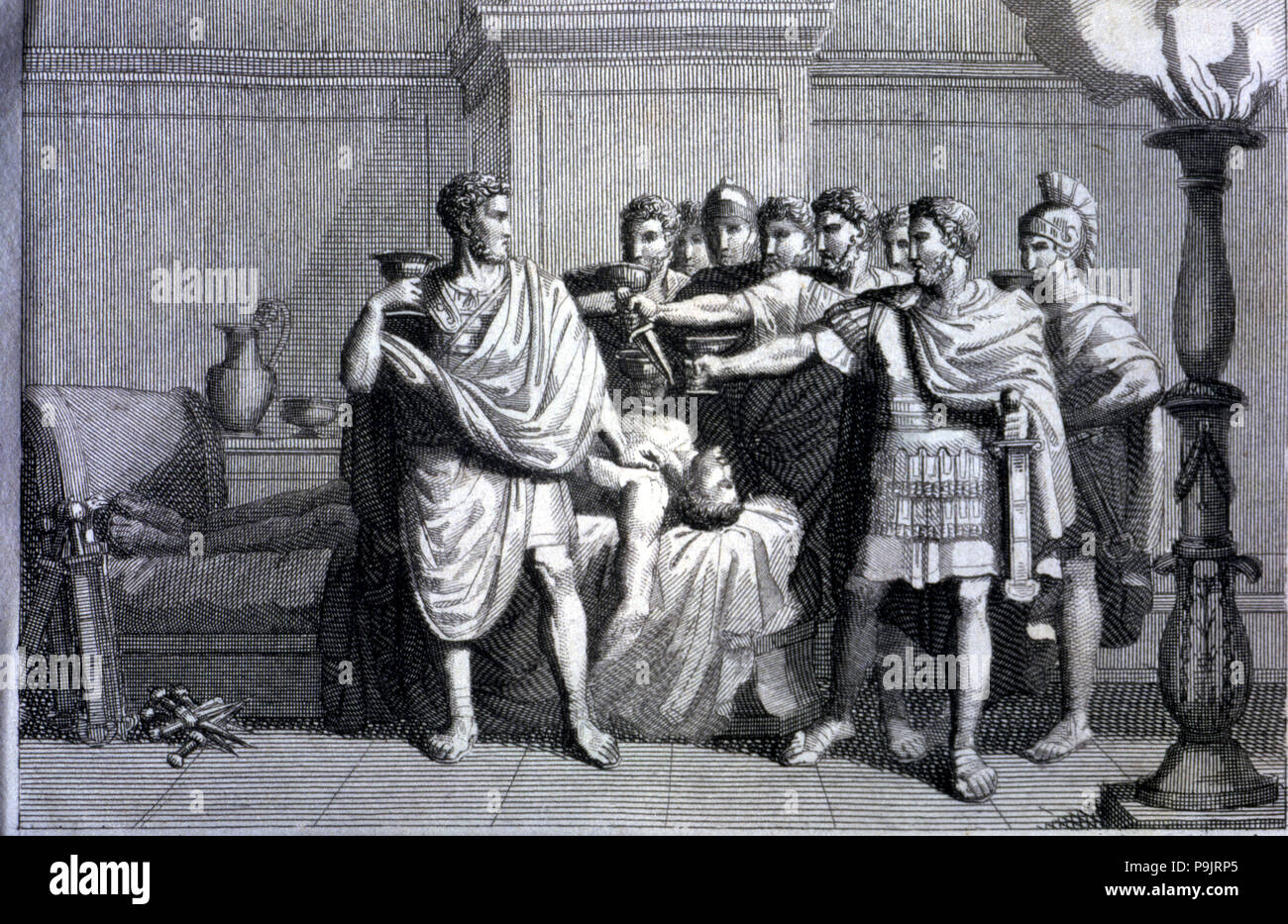 Conspiracy of Lucius Sergius Catiline (108-62 a.C.) to achieve by force the power of the Consulat… Stock Photohttps://www.alamy.com/image-license-details/?v=1https://www.alamy.com/conspiracy-of-lucius-sergius-catiline-108-62-ac-to-achieve-by-force-the-power-of-the-consulat-image212470109.html
Conspiracy of Lucius Sergius Catiline (108-62 a.C.) to achieve by force the power of the Consulat… Stock Photohttps://www.alamy.com/image-license-details/?v=1https://www.alamy.com/conspiracy-of-lucius-sergius-catiline-108-62-ac-to-achieve-by-force-the-power-of-the-consulat-image212470109.htmlRMP9JRP5–Conspiracy of Lucius Sergius Catiline (108-62 a.C.) to achieve by force the power of the Consulat…
 Comic History of Rome Table 10 Cicero denouncing Catiline Stock Photohttps://www.alamy.com/image-license-details/?v=1https://www.alamy.com/stock-photo-comic-history-of-rome-table-10-cicero-denouncing-catiline-142541807.html
Comic History of Rome Table 10 Cicero denouncing Catiline Stock Photohttps://www.alamy.com/image-license-details/?v=1https://www.alamy.com/stock-photo-comic-history-of-rome-table-10-cicero-denouncing-catiline-142541807.htmlRMJ7W9ER–Comic History of Rome Table 10 Cicero denouncing Catiline
 Cicero In The Senate Stock Photohttps://www.alamy.com/image-license-details/?v=1https://www.alamy.com/cicero-in-the-senate-image5074070.html
Cicero In The Senate Stock Photohttps://www.alamy.com/image-license-details/?v=1https://www.alamy.com/cicero-in-the-senate-image5074070.htmlRMANJM97–Cicero In The Senate
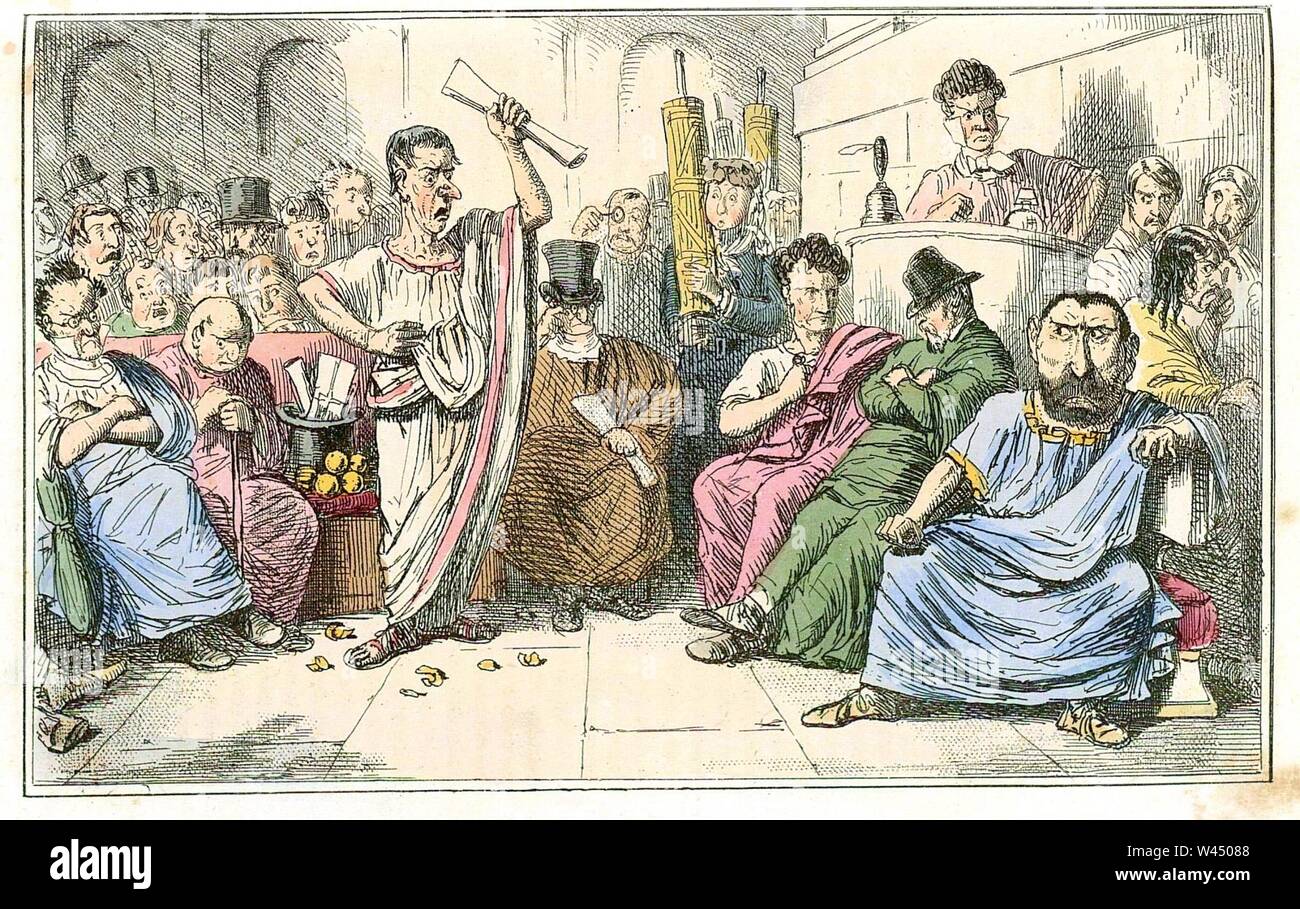 Comic History of Rome Table 10 Cicero denouncing Catiline. Stock Photohttps://www.alamy.com/image-license-details/?v=1https://www.alamy.com/comic-history-of-rome-table-10-cicero-denouncing-catiline-image260724136.html
Comic History of Rome Table 10 Cicero denouncing Catiline. Stock Photohttps://www.alamy.com/image-license-details/?v=1https://www.alamy.com/comic-history-of-rome-table-10-cicero-denouncing-catiline-image260724136.htmlRMW45088–Comic History of Rome Table 10 Cicero denouncing Catiline.
 Cicero, Catiline Orations, Florence, Plut. 48,22 Stock Photohttps://www.alamy.com/image-license-details/?v=1https://www.alamy.com/stock-photo-cicero-catiline-orations-florence-plut-4822-136483958.html
Cicero, Catiline Orations, Florence, Plut. 48,22 Stock Photohttps://www.alamy.com/image-license-details/?v=1https://www.alamy.com/stock-photo-cicero-catiline-orations-florence-plut-4822-136483958.htmlRMHX1AK2–Cicero, Catiline Orations, Florence, Plut. 48,22
 Catiline Conspiracy Stock Photohttps://www.alamy.com/image-license-details/?v=1https://www.alamy.com/stock-photo-catiline-conspiracy-56758494.html
Catiline Conspiracy Stock Photohttps://www.alamy.com/image-license-details/?v=1https://www.alamy.com/stock-photo-catiline-conspiracy-56758494.htmlRMD89G12–Catiline Conspiracy
 The Catiline Conspiracy, 1792. Stock Photohttps://www.alamy.com/image-license-details/?v=1https://www.alamy.com/the-catiline-conspiracy-1792-image426157828.html
The Catiline Conspiracy, 1792. Stock Photohttps://www.alamy.com/image-license-details/?v=1https://www.alamy.com/the-catiline-conspiracy-1792-image426157828.htmlRM2FN94JC–The Catiline Conspiracy, 1792.
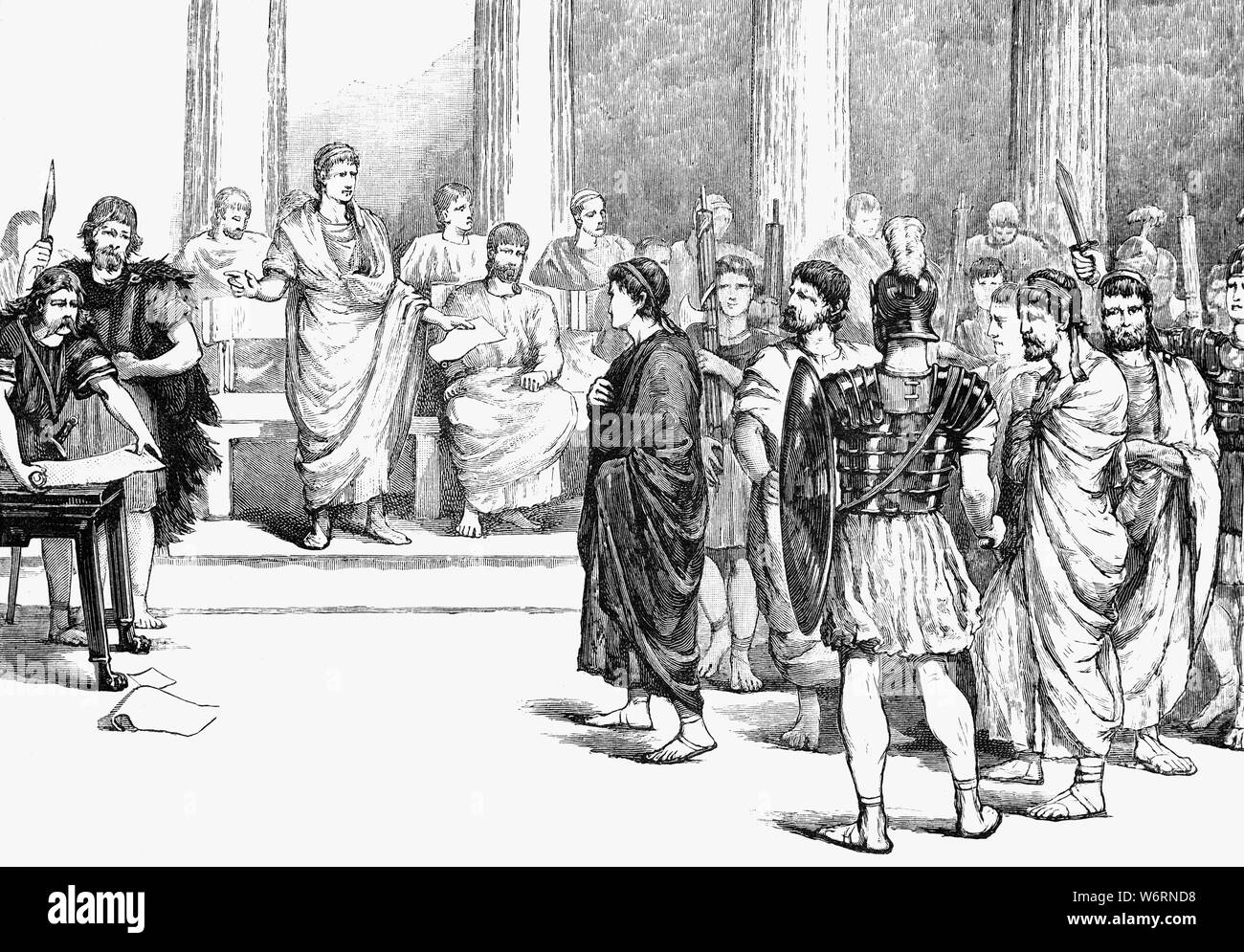 The Catilinarian conspirators before the Senate. they included Lucius Sergius Catilina (108–62 BCE), Roman Senator of the 1st century BC who devised the plot with the help of a group of aristocrats and disaffected veterans, to overthrow the Roman Republic in 63 BC. Cicero exposed the plot, which forced Catiline to flee from Rome. The five conspirators were condemned to death but fearing that other conspirators might try to free them, Cicero had them strangled in the Tullianum immediately and an end was made to the conspiracy in Rome. Stock Photohttps://www.alamy.com/image-license-details/?v=1https://www.alamy.com/the-catilinarian-conspirators-before-the-senate-they-included-lucius-sergius-catilina-10862-bce-roman-senator-of-the-1st-century-bc-who-devised-the-plot-with-the-help-of-a-group-of-aristocrats-and-disaffected-veterans-to-overthrow-the-roman-republic-in-63-bc-cicero-exposed-the-plot-which-forced-catiline-to-flee-from-rome-the-five-conspirators-were-condemned-to-death-but-fearing-that-other-conspirators-might-try-to-free-them-cicero-had-them-strangled-in-the-tullianum-immediately-and-an-end-was-made-to-the-conspiracy-in-rome-image262365188.html
The Catilinarian conspirators before the Senate. they included Lucius Sergius Catilina (108–62 BCE), Roman Senator of the 1st century BC who devised the plot with the help of a group of aristocrats and disaffected veterans, to overthrow the Roman Republic in 63 BC. Cicero exposed the plot, which forced Catiline to flee from Rome. The five conspirators were condemned to death but fearing that other conspirators might try to free them, Cicero had them strangled in the Tullianum immediately and an end was made to the conspiracy in Rome. Stock Photohttps://www.alamy.com/image-license-details/?v=1https://www.alamy.com/the-catilinarian-conspirators-before-the-senate-they-included-lucius-sergius-catilina-10862-bce-roman-senator-of-the-1st-century-bc-who-devised-the-plot-with-the-help-of-a-group-of-aristocrats-and-disaffected-veterans-to-overthrow-the-roman-republic-in-63-bc-cicero-exposed-the-plot-which-forced-catiline-to-flee-from-rome-the-five-conspirators-were-condemned-to-death-but-fearing-that-other-conspirators-might-try-to-free-them-cicero-had-them-strangled-in-the-tullianum-immediately-and-an-end-was-made-to-the-conspiracy-in-rome-image262365188.htmlRMW6RND8–The Catilinarian conspirators before the Senate. they included Lucius Sergius Catilina (108–62 BCE), Roman Senator of the 1st century BC who devised the plot with the help of a group of aristocrats and disaffected veterans, to overthrow the Roman Republic in 63 BC. Cicero exposed the plot, which forced Catiline to flee from Rome. The five conspirators were condemned to death but fearing that other conspirators might try to free them, Cicero had them strangled in the Tullianum immediately and an end was made to the conspiracy in Rome.
 . English: Cicero, end of the 4th Catiliniarian Oration, in a manuscript written by Poggio Bracciolini. Florence, Biblioteca Medicea Laurenziana, Plut. 48,22, fol. 121r. Deutsch: Cicero, Ende der vierten Catilinarischen Rede, in einer von Poggio Bracciolini geschriebenen Handschrift. Florenz, Biblioteca Medicea Laurenziana, Plut. 48,22, fol. 121r. 1425. Cicero 131 Cicero, Catiline Orations, Florence, Plut. 48,22 Stock Photohttps://www.alamy.com/image-license-details/?v=1https://www.alamy.com/english-cicero-end-of-the-4th-catiliniarian-oration-in-a-manuscript-written-by-poggio-bracciolini-florence-biblioteca-medicea-laurenziana-plut-4822-fol-121r-deutsch-cicero-ende-der-vierten-catilinarischen-rede-in-einer-von-poggio-bracciolini-geschriebenen-handschrift-florenz-biblioteca-medicea-laurenziana-plut-4822-fol-121r-1425-cicero-131-cicero-catiline-orations-florence-plut-4822-image187590395.html
. English: Cicero, end of the 4th Catiliniarian Oration, in a manuscript written by Poggio Bracciolini. Florence, Biblioteca Medicea Laurenziana, Plut. 48,22, fol. 121r. Deutsch: Cicero, Ende der vierten Catilinarischen Rede, in einer von Poggio Bracciolini geschriebenen Handschrift. Florenz, Biblioteca Medicea Laurenziana, Plut. 48,22, fol. 121r. 1425. Cicero 131 Cicero, Catiline Orations, Florence, Plut. 48,22 Stock Photohttps://www.alamy.com/image-license-details/?v=1https://www.alamy.com/english-cicero-end-of-the-4th-catiliniarian-oration-in-a-manuscript-written-by-poggio-bracciolini-florence-biblioteca-medicea-laurenziana-plut-4822-fol-121r-deutsch-cicero-ende-der-vierten-catilinarischen-rede-in-einer-von-poggio-bracciolini-geschriebenen-handschrift-florenz-biblioteca-medicea-laurenziana-plut-4822-fol-121r-1425-cicero-131-cicero-catiline-orations-florence-plut-4822-image187590395.htmlRMMW5DCY–. English: Cicero, end of the 4th Catiliniarian Oration, in a manuscript written by Poggio Bracciolini. Florence, Biblioteca Medicea Laurenziana, Plut. 48,22, fol. 121r. Deutsch: Cicero, Ende der vierten Catilinarischen Rede, in einer von Poggio Bracciolini geschriebenen Handschrift. Florenz, Biblioteca Medicea Laurenziana, Plut. 48,22, fol. 121r. 1425. Cicero 131 Cicero, Catiline Orations, Florence, Plut. 48,22
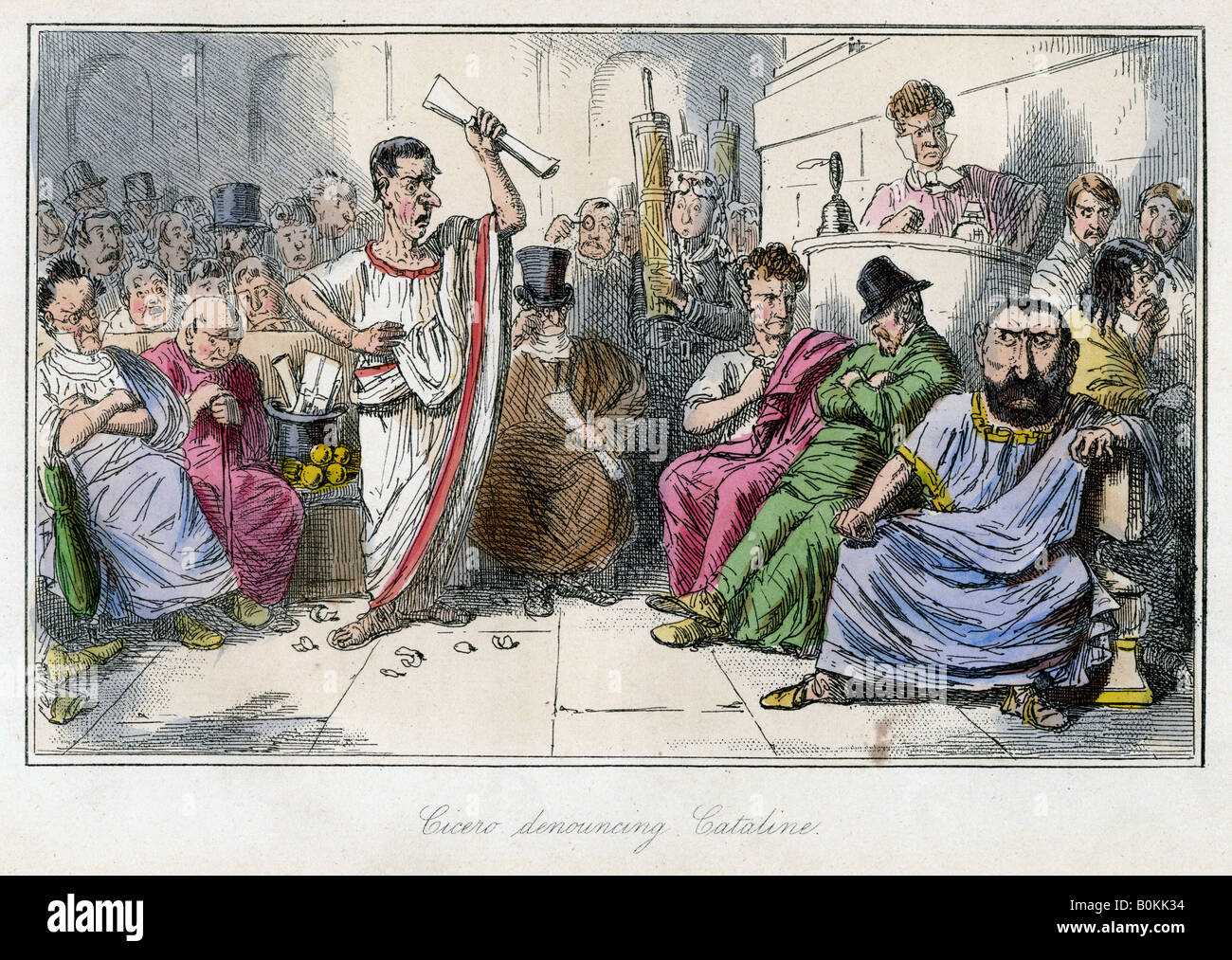 'Cicero denouncing Cataline', 1850s.Artist: John Leech Stock Photohttps://www.alamy.com/image-license-details/?v=1https://www.alamy.com/stock-photo-cicero-denouncing-cataline-1850sartist-john-leech-17642440.html
'Cicero denouncing Cataline', 1850s.Artist: John Leech Stock Photohttps://www.alamy.com/image-license-details/?v=1https://www.alamy.com/stock-photo-cicero-denouncing-cataline-1850sartist-john-leech-17642440.htmlRMB0KK34–'Cicero denouncing Cataline', 1850s.Artist: John Leech
 Ridpath's Universal history : an account of the origin, primitive condition and ethnic development of the great races of mankind, and of the principal events in the evolution and progress of the civilized life among men and nations, from recent and authentic sources with a preliminary inquiry on the time, place and manner of the beginning . the cause of Catiline. The conspirators were now arraigned fortrial. It was the occasion of a stormy scenein the Senate. Silaxus, the consul-elect, fa-vored the sentence of death. Ctesar spoke forlife-imprisonment and coufiscation of goods.Quintus Cicero to Stock Photohttps://www.alamy.com/image-license-details/?v=1https://www.alamy.com/ridpaths-universal-history-an-account-of-the-origin-primitive-condition-and-ethnic-development-of-the-great-races-of-mankind-and-of-the-principal-events-in-the-evolution-and-progress-of-the-civilized-life-among-men-and-nations-from-recent-and-authentic-sources-with-a-preliminary-inquiry-on-the-time-place-and-manner-of-the-beginning-the-cause-of-catiline-the-conspirators-were-now-arraigned-fortrial-it-was-the-occasion-of-a-stormy-scenein-the-senate-silaxus-the-consul-elect-fa-vored-the-sentence-of-death-ctesar-spoke-forlife-imprisonment-and-coufiscation-of-goodsquintus-cicero-to-image338485126.html
Ridpath's Universal history : an account of the origin, primitive condition and ethnic development of the great races of mankind, and of the principal events in the evolution and progress of the civilized life among men and nations, from recent and authentic sources with a preliminary inquiry on the time, place and manner of the beginning . the cause of Catiline. The conspirators were now arraigned fortrial. It was the occasion of a stormy scenein the Senate. Silaxus, the consul-elect, fa-vored the sentence of death. Ctesar spoke forlife-imprisonment and coufiscation of goods.Quintus Cicero to Stock Photohttps://www.alamy.com/image-license-details/?v=1https://www.alamy.com/ridpaths-universal-history-an-account-of-the-origin-primitive-condition-and-ethnic-development-of-the-great-races-of-mankind-and-of-the-principal-events-in-the-evolution-and-progress-of-the-civilized-life-among-men-and-nations-from-recent-and-authentic-sources-with-a-preliminary-inquiry-on-the-time-place-and-manner-of-the-beginning-the-cause-of-catiline-the-conspirators-were-now-arraigned-fortrial-it-was-the-occasion-of-a-stormy-scenein-the-senate-silaxus-the-consul-elect-fa-vored-the-sentence-of-death-ctesar-spoke-forlife-imprisonment-and-coufiscation-of-goodsquintus-cicero-to-image338485126.htmlRM2AJK96E–Ridpath's Universal history : an account of the origin, primitive condition and ethnic development of the great races of mankind, and of the principal events in the evolution and progress of the civilized life among men and nations, from recent and authentic sources with a preliminary inquiry on the time, place and manner of the beginning . the cause of Catiline. The conspirators were now arraigned fortrial. It was the occasion of a stormy scenein the Senate. Silaxus, the consul-elect, fa-vored the sentence of death. Ctesar spoke forlife-imprisonment and coufiscation of goods.Quintus Cicero to
 . English: Cicero, end of the 4th Catiliniarian Oration, in a manuscript written by Poggio Bracciolini. Florence, Biblioteca Medicea Laurenziana, Plut. 48,22, fol. 121r. Deutsch: Cicero, Ende der vierten Catilinarischen Rede, in einer von Poggio Bracciolini geschriebenen Handschrift. Florenz, Biblioteca Medicea Laurenziana, Plut. 48,22, fol. 121r. 1425. Cicero 113 Cicero, Catiline Orations, Florence, Plut. 48,22 Stock Photohttps://www.alamy.com/image-license-details/?v=1https://www.alamy.com/english-cicero-end-of-the-4th-catiliniarian-oration-in-a-manuscript-written-by-poggio-bracciolini-florence-biblioteca-medicea-laurenziana-plut-4822-fol-121r-deutsch-cicero-ende-der-vierten-catilinarischen-rede-in-einer-von-poggio-bracciolini-geschriebenen-handschrift-florenz-biblioteca-medicea-laurenziana-plut-4822-fol-121r-1425-cicero-113-cicero-catiline-orations-florence-plut-4822-image188880860.html
. English: Cicero, end of the 4th Catiliniarian Oration, in a manuscript written by Poggio Bracciolini. Florence, Biblioteca Medicea Laurenziana, Plut. 48,22, fol. 121r. Deutsch: Cicero, Ende der vierten Catilinarischen Rede, in einer von Poggio Bracciolini geschriebenen Handschrift. Florenz, Biblioteca Medicea Laurenziana, Plut. 48,22, fol. 121r. 1425. Cicero 113 Cicero, Catiline Orations, Florence, Plut. 48,22 Stock Photohttps://www.alamy.com/image-license-details/?v=1https://www.alamy.com/english-cicero-end-of-the-4th-catiliniarian-oration-in-a-manuscript-written-by-poggio-bracciolini-florence-biblioteca-medicea-laurenziana-plut-4822-fol-121r-deutsch-cicero-ende-der-vierten-catilinarischen-rede-in-einer-von-poggio-bracciolini-geschriebenen-handschrift-florenz-biblioteca-medicea-laurenziana-plut-4822-fol-121r-1425-cicero-113-cicero-catiline-orations-florence-plut-4822-image188880860.htmlRMMY87D0–. English: Cicero, end of the 4th Catiliniarian Oration, in a manuscript written by Poggio Bracciolini. Florence, Biblioteca Medicea Laurenziana, Plut. 48,22, fol. 121r. Deutsch: Cicero, Ende der vierten Catilinarischen Rede, in einer von Poggio Bracciolini geschriebenen Handschrift. Florenz, Biblioteca Medicea Laurenziana, Plut. 48,22, fol. 121r. 1425. Cicero 113 Cicero, Catiline Orations, Florence, Plut. 48,22
 Pennsylvania at Gettysburg : ceremonies at the dedication of the monuments erected by the Commonwealth of Pennsylvania to Major General George G Meade, Major General Winfield S Hancock, Major General John F Reynolds and to mark the positions of the Pennsylvania commands engaged in the battle . Faneuil Hall, Henry WardBeecher in England, and Abraham Lincoln at Gettysburg. Marathongave us Pericles oration, the sedition of Catiline gave us the orationof Cicero, the struggle in India gave us Burkes indictment of War-ren Hastings, and the collision between Union and Secession gaveus Abraham Lincoln Stock Photohttps://www.alamy.com/image-license-details/?v=1https://www.alamy.com/pennsylvania-at-gettysburg-ceremonies-at-the-dedication-of-the-monuments-erected-by-the-commonwealth-of-pennsylvania-to-major-general-george-g-meade-major-general-winfield-s-hancock-major-general-john-f-reynolds-and-to-mark-the-positions-of-the-pennsylvania-commands-engaged-in-the-battle-faneuil-hall-henry-wardbeecher-in-england-and-abraham-lincoln-at-gettysburg-marathongave-us-pericles-oration-the-sedition-of-catiline-gave-us-the-orationof-cicero-the-struggle-in-india-gave-us-burkes-indictment-of-war-ren-hastings-and-the-collision-between-union-and-secession-gaveus-abraham-lincoln-image338394829.html
Pennsylvania at Gettysburg : ceremonies at the dedication of the monuments erected by the Commonwealth of Pennsylvania to Major General George G Meade, Major General Winfield S Hancock, Major General John F Reynolds and to mark the positions of the Pennsylvania commands engaged in the battle . Faneuil Hall, Henry WardBeecher in England, and Abraham Lincoln at Gettysburg. Marathongave us Pericles oration, the sedition of Catiline gave us the orationof Cicero, the struggle in India gave us Burkes indictment of War-ren Hastings, and the collision between Union and Secession gaveus Abraham Lincoln Stock Photohttps://www.alamy.com/image-license-details/?v=1https://www.alamy.com/pennsylvania-at-gettysburg-ceremonies-at-the-dedication-of-the-monuments-erected-by-the-commonwealth-of-pennsylvania-to-major-general-george-g-meade-major-general-winfield-s-hancock-major-general-john-f-reynolds-and-to-mark-the-positions-of-the-pennsylvania-commands-engaged-in-the-battle-faneuil-hall-henry-wardbeecher-in-england-and-abraham-lincoln-at-gettysburg-marathongave-us-pericles-oration-the-sedition-of-catiline-gave-us-the-orationof-cicero-the-struggle-in-india-gave-us-burkes-indictment-of-war-ren-hastings-and-the-collision-between-union-and-secession-gaveus-abraham-lincoln-image338394829.htmlRM2AJF61H–Pennsylvania at Gettysburg : ceremonies at the dedication of the monuments erected by the Commonwealth of Pennsylvania to Major General George G Meade, Major General Winfield S Hancock, Major General John F Reynolds and to mark the positions of the Pennsylvania commands engaged in the battle . Faneuil Hall, Henry WardBeecher in England, and Abraham Lincoln at Gettysburg. Marathongave us Pericles oration, the sedition of Catiline gave us the orationof Cicero, the struggle in India gave us Burkes indictment of War-ren Hastings, and the collision between Union and Secession gaveus Abraham Lincoln
 131 Cicero, Catiline Orations, Florence, Plut. 48,22 Stock Photohttps://www.alamy.com/image-license-details/?v=1https://www.alamy.com/131-cicero-catiline-orations-florence-plut-4822-image214144787.html
131 Cicero, Catiline Orations, Florence, Plut. 48,22 Stock Photohttps://www.alamy.com/image-license-details/?v=1https://www.alamy.com/131-cicero-catiline-orations-florence-plut-4822-image214144787.htmlRMPCB3T3–131 Cicero, Catiline Orations, Florence, Plut. 48,22
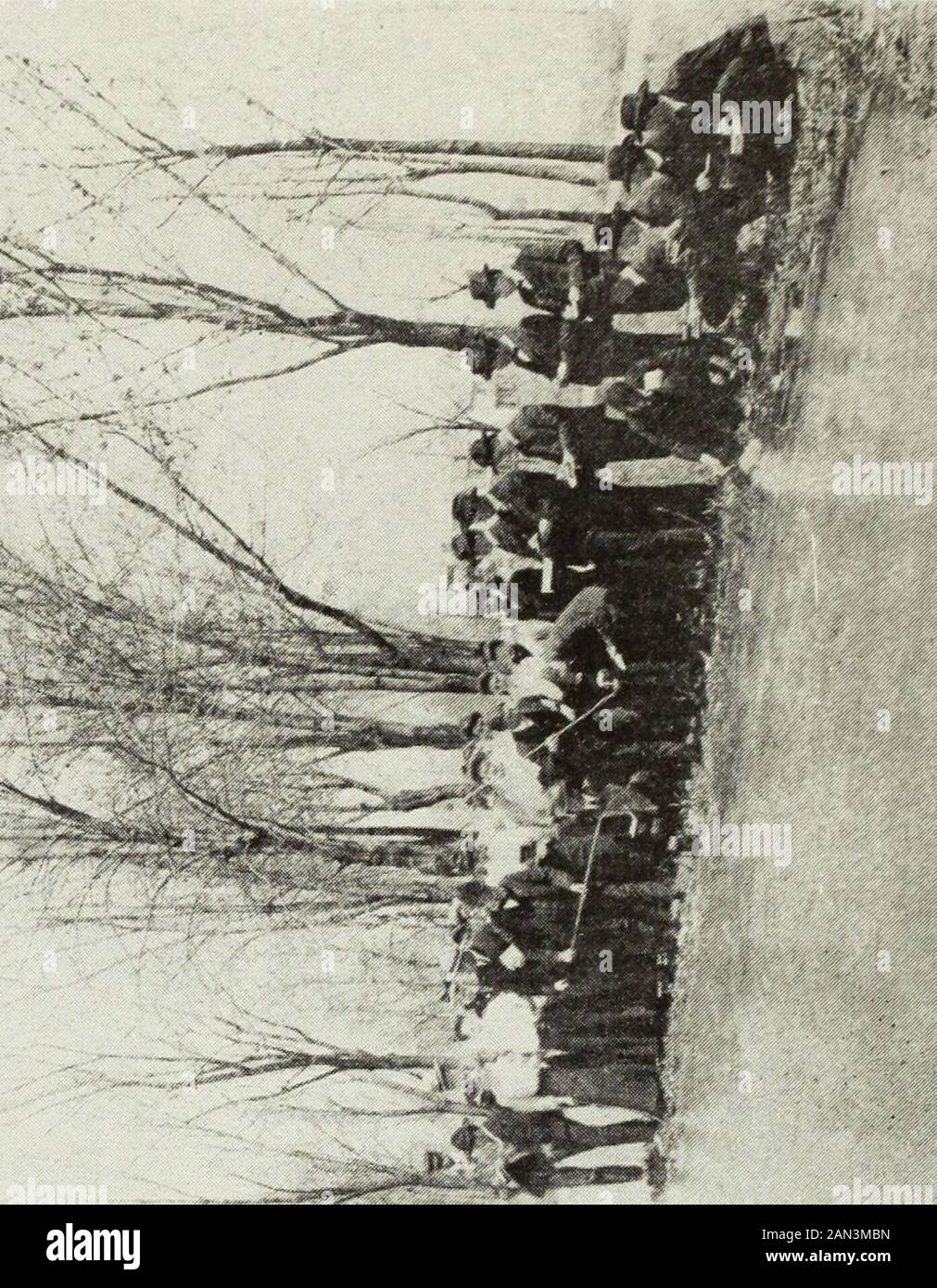 Annual catalogue of the Southern Illinois Normal University, Carbondale, Jackson County, Illinois, 1875-1892 . se composition based on the first four books is taken from HalesLatin Composition. Hale and Bucks Latin Grammar. Seventh Term, (F). Orations of Cicero. First three againstCatiline with selections from Sallusts Catiline and prose composition. Eighth Term, (E). Cicero. The fourth against Catiline withselections from Sallust, the orations for the Manilian Law and thepoet Archias. Daniells Prose Composition. (D). Ninth Term. Ovid. Selections from the Metamorphoses,about 1,500 verses. Gree Stock Photohttps://www.alamy.com/image-license-details/?v=1https://www.alamy.com/annual-catalogue-of-the-southern-illinois-normal-university-carbondale-jackson-county-illinois-1875-1892-se-composition-based-on-the-first-four-books-is-taken-from-haleslatin-composition-hale-and-bucks-latin-grammar-seventh-term-f-orations-of-cicero-first-three-againstcatiline-with-selections-from-sallusts-catiline-and-prose-composition-eighth-term-e-cicero-the-fourth-against-catiline-withselections-from-sallust-the-orations-for-the-manilian-law-and-thepoet-archias-daniells-prose-composition-d-ninth-term-ovid-selections-from-the-metamorphosesabout-1500-verses-gree-image339986633.html
Annual catalogue of the Southern Illinois Normal University, Carbondale, Jackson County, Illinois, 1875-1892 . se composition based on the first four books is taken from HalesLatin Composition. Hale and Bucks Latin Grammar. Seventh Term, (F). Orations of Cicero. First three againstCatiline with selections from Sallusts Catiline and prose composition. Eighth Term, (E). Cicero. The fourth against Catiline withselections from Sallust, the orations for the Manilian Law and thepoet Archias. Daniells Prose Composition. (D). Ninth Term. Ovid. Selections from the Metamorphoses,about 1,500 verses. Gree Stock Photohttps://www.alamy.com/image-license-details/?v=1https://www.alamy.com/annual-catalogue-of-the-southern-illinois-normal-university-carbondale-jackson-county-illinois-1875-1892-se-composition-based-on-the-first-four-books-is-taken-from-haleslatin-composition-hale-and-bucks-latin-grammar-seventh-term-f-orations-of-cicero-first-three-againstcatiline-with-selections-from-sallusts-catiline-and-prose-composition-eighth-term-e-cicero-the-fourth-against-catiline-withselections-from-sallust-the-orations-for-the-manilian-law-and-thepoet-archias-daniells-prose-composition-d-ninth-term-ovid-selections-from-the-metamorphosesabout-1500-verses-gree-image339986633.htmlRM2AN3MBN–Annual catalogue of the Southern Illinois Normal University, Carbondale, Jackson County, Illinois, 1875-1892 . se composition based on the first four books is taken from HalesLatin Composition. Hale and Bucks Latin Grammar. Seventh Term, (F). Orations of Cicero. First three againstCatiline with selections from Sallusts Catiline and prose composition. Eighth Term, (E). Cicero. The fourth against Catiline withselections from Sallust, the orations for the Manilian Law and thepoet Archias. Daniells Prose Composition. (D). Ninth Term. Ovid. Selections from the Metamorphoses,about 1,500 verses. Gree
 N/A. Image by John Leech, from: The Comic History of Rome by Gilbert Abbott A Beckett. Bradbury, Evans & Co, London, 1850s Disraeli (as Cicero) denouncing W. E. Gladstone (as Catiline) . circa 1850. John Leech (1817–1864) Alternative names John Leech Description English caricaturist and illustrator Date of birth/death 29 August 1817 29 October 1864 Location of birth/death London London Authority control : Q1374807 VIAF:55323488 ISNI:0000 0001 0903 3018 ULAN:500002592 LCCN:n79054670 NLA:35297707 WorldCat 372 Comic History of Rome Table 10 Cicero denouncing Catiline Stock Photohttps://www.alamy.com/image-license-details/?v=1https://www.alamy.com/na-image-by-john-leech-from-the-comic-history-of-rome-by-gilbert-abbott-a-beckett-bradbury-evans-co-london-1850s-disraeli-as-cicero-denouncing-w-e-gladstone-as-catiline-circa-1850-john-leech-18171864-alternative-names-john-leech-description-english-caricaturist-and-illustrator-date-of-birthdeath-29-august-1817-29-october-1864-location-of-birthdeath-london-london-authority-control-q1374807-viaf55323488-isni0000-0001-0903-3018-ulan500002592-lccnn79054670-nla35297707-worldcat-372-comic-history-of-rome-table-10-cicero-denouncing-catiline-image210181377.html
N/A. Image by John Leech, from: The Comic History of Rome by Gilbert Abbott A Beckett. Bradbury, Evans & Co, London, 1850s Disraeli (as Cicero) denouncing W. E. Gladstone (as Catiline) . circa 1850. John Leech (1817–1864) Alternative names John Leech Description English caricaturist and illustrator Date of birth/death 29 August 1817 29 October 1864 Location of birth/death London London Authority control : Q1374807 VIAF:55323488 ISNI:0000 0001 0903 3018 ULAN:500002592 LCCN:n79054670 NLA:35297707 WorldCat 372 Comic History of Rome Table 10 Cicero denouncing Catiline Stock Photohttps://www.alamy.com/image-license-details/?v=1https://www.alamy.com/na-image-by-john-leech-from-the-comic-history-of-rome-by-gilbert-abbott-a-beckett-bradbury-evans-co-london-1850s-disraeli-as-cicero-denouncing-w-e-gladstone-as-catiline-circa-1850-john-leech-18171864-alternative-names-john-leech-description-english-caricaturist-and-illustrator-date-of-birthdeath-29-august-1817-29-october-1864-location-of-birthdeath-london-london-authority-control-q1374807-viaf55323488-isni0000-0001-0903-3018-ulan500002592-lccnn79054670-nla35297707-worldcat-372-comic-history-of-rome-table-10-cicero-denouncing-catiline-image210181377.htmlRMP5XGDN–N/A. Image by John Leech, from: The Comic History of Rome by Gilbert Abbott A Beckett. Bradbury, Evans & Co, London, 1850s Disraeli (as Cicero) denouncing W. E. Gladstone (as Catiline) . circa 1850. John Leech (1817–1864) Alternative names John Leech Description English caricaturist and illustrator Date of birth/death 29 August 1817 29 October 1864 Location of birth/death London London Authority control : Q1374807 VIAF:55323488 ISNI:0000 0001 0903 3018 ULAN:500002592 LCCN:n79054670 NLA:35297707 WorldCat 372 Comic History of Rome Table 10 Cicero denouncing Catiline
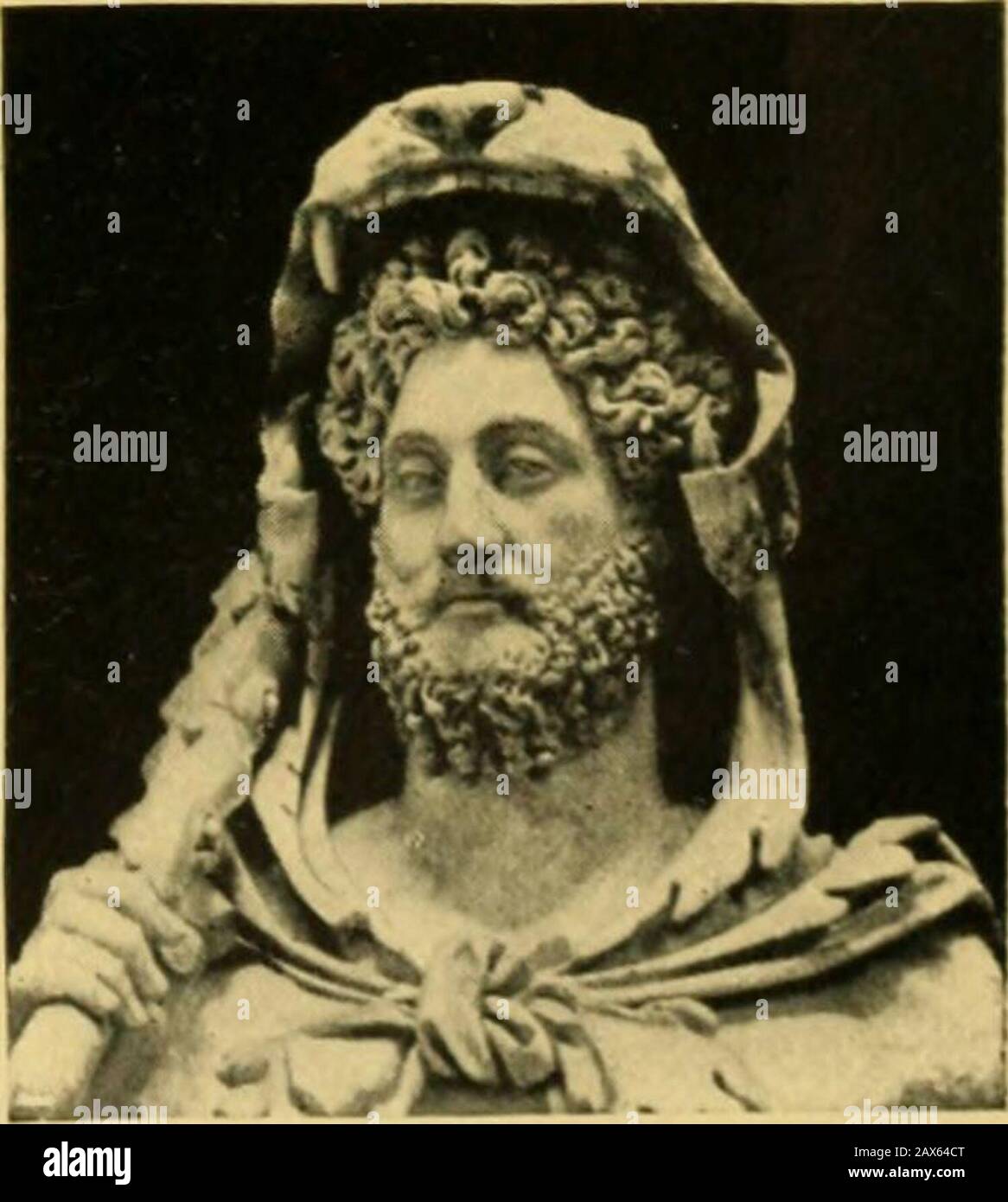 A history of the ancient world, for high schools and academies . Faustina Commodus TYPICAL ROMAN HEADS Pompey in the East 345 citizens, optimatcs and equitcs united, elected Cicero asone of the consuls in the years 64 and 63 B.C. He showeduncommon skill and courage in grappling with it, un- ciceroearthed the conspirators and impeached them. Though ^^^®**^^°^Catiline fled, other leaders were seized, and on the author-ity of the senate put to death by the consul. In 62 B.C.Catiline, who had gathered an army, was overthrown inbattle and died fighting. It was Ciceros one splendidpoHtical success i Stock Photohttps://www.alamy.com/image-license-details/?v=1https://www.alamy.com/a-history-of-the-ancient-world-for-high-schools-and-academies-faustina-commodus-typical-roman-heads-pompey-in-the-east-345-citizens-optimatcs-and-equitcs-united-elected-cicero-asone-of-the-consuls-in-the-years-64-and-63-bc-he-showeduncommon-skill-and-courage-in-grappling-with-it-un-ciceroearthed-the-conspirators-and-impeached-them-though-catiline-fled-other-leaders-were-seized-and-on-the-author-ity-of-the-senate-put-to-death-by-the-consul-in-62-bccatiline-who-had-gathered-an-army-was-overthrown-inbattle-and-died-fighting-it-was-ciceros-one-splendidpohtical-success-i-image343113256.html
A history of the ancient world, for high schools and academies . Faustina Commodus TYPICAL ROMAN HEADS Pompey in the East 345 citizens, optimatcs and equitcs united, elected Cicero asone of the consuls in the years 64 and 63 B.C. He showeduncommon skill and courage in grappling with it, un- ciceroearthed the conspirators and impeached them. Though ^^^®**^^°^Catiline fled, other leaders were seized, and on the author-ity of the senate put to death by the consul. In 62 B.C.Catiline, who had gathered an army, was overthrown inbattle and died fighting. It was Ciceros one splendidpoHtical success i Stock Photohttps://www.alamy.com/image-license-details/?v=1https://www.alamy.com/a-history-of-the-ancient-world-for-high-schools-and-academies-faustina-commodus-typical-roman-heads-pompey-in-the-east-345-citizens-optimatcs-and-equitcs-united-elected-cicero-asone-of-the-consuls-in-the-years-64-and-63-bc-he-showeduncommon-skill-and-courage-in-grappling-with-it-un-ciceroearthed-the-conspirators-and-impeached-them-though-catiline-fled-other-leaders-were-seized-and-on-the-author-ity-of-the-senate-put-to-death-by-the-consul-in-62-bccatiline-who-had-gathered-an-army-was-overthrown-inbattle-and-died-fighting-it-was-ciceros-one-splendidpohtical-success-i-image343113256.htmlRM2AX64CT–A history of the ancient world, for high schools and academies . Faustina Commodus TYPICAL ROMAN HEADS Pompey in the East 345 citizens, optimatcs and equitcs united, elected Cicero asone of the consuls in the years 64 and 63 B.C. He showeduncommon skill and courage in grappling with it, un- ciceroearthed the conspirators and impeached them. Though ^^^®**^^°^Catiline fled, other leaders were seized, and on the author-ity of the senate put to death by the consul. In 62 B.C.Catiline, who had gathered an army, was overthrown inbattle and died fighting. It was Ciceros one splendidpoHtical success i
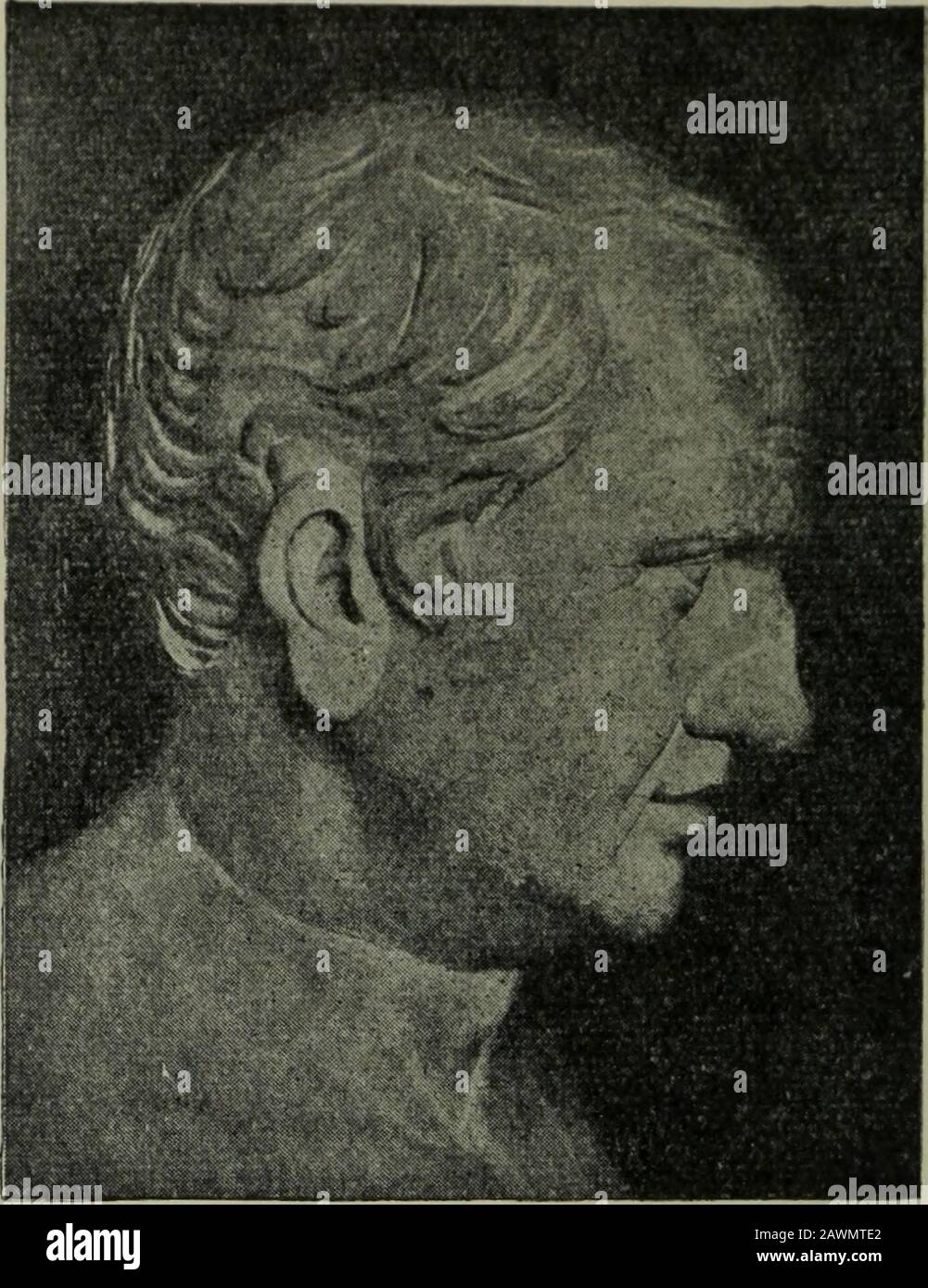 The Catiline of Sallust . Portrait of Cicero (?) in the Chiaramonti Museum. ©Icmmtarn Classics The Catiline of Sallust Edited for the Use of Schools^ with Introduction^Notes^ and Vocabulary by G. H. Nail, M.A. Assistant Master at Westminster School WITH ILLUSTRATIONS LONDON MACMILLAN & CO LTD NEW YORK • ST martins PRESS I961 This hook is copyright in all countries whichare signatories to the Berne Convention a- First Edition igoo Re-issue, with Illustratioyis, igo2 Reprinted igoy, igii, igig, ig25, ig2g, ig36 ig4i {twice), ig42, ig48, ig53, ig6i MACMILLAN AND COMPANY LIMITED London Bombay Calc Stock Photohttps://www.alamy.com/image-license-details/?v=1https://www.alamy.com/the-catiline-of-sallust-portrait-of-cicero-in-the-chiaramonti-museum-icmmtarn-classics-the-catiline-of-sallust-edited-for-the-use-of-schools-with-introductionnotes-and-vocabulary-by-g-h-nail-ma-assistant-master-at-westminster-school-with-illustrations-london-macmillan-co-ltd-new-york-st-martins-press-i961-this-hook-is-copyright-in-all-countries-whichare-signatories-to-the-berne-convention-a-first-edition-igoo-re-issue-with-illustratioyis-igo2-reprinted-igoy-igii-igig-ig25-ig2g-ig36-ig4i-twice-ig42-ig48-ig53-ig6i-macmillan-and-company-limited-london-bombay-calc-image342821642.html
The Catiline of Sallust . Portrait of Cicero (?) in the Chiaramonti Museum. ©Icmmtarn Classics The Catiline of Sallust Edited for the Use of Schools^ with Introduction^Notes^ and Vocabulary by G. H. Nail, M.A. Assistant Master at Westminster School WITH ILLUSTRATIONS LONDON MACMILLAN & CO LTD NEW YORK • ST martins PRESS I961 This hook is copyright in all countries whichare signatories to the Berne Convention a- First Edition igoo Re-issue, with Illustratioyis, igo2 Reprinted igoy, igii, igig, ig25, ig2g, ig36 ig4i {twice), ig42, ig48, ig53, ig6i MACMILLAN AND COMPANY LIMITED London Bombay Calc Stock Photohttps://www.alamy.com/image-license-details/?v=1https://www.alamy.com/the-catiline-of-sallust-portrait-of-cicero-in-the-chiaramonti-museum-icmmtarn-classics-the-catiline-of-sallust-edited-for-the-use-of-schools-with-introductionnotes-and-vocabulary-by-g-h-nail-ma-assistant-master-at-westminster-school-with-illustrations-london-macmillan-co-ltd-new-york-st-martins-press-i961-this-hook-is-copyright-in-all-countries-whichare-signatories-to-the-berne-convention-a-first-edition-igoo-re-issue-with-illustratioyis-igo2-reprinted-igoy-igii-igig-ig25-ig2g-ig36-ig4i-twice-ig42-ig48-ig53-ig6i-macmillan-and-company-limited-london-bombay-calc-image342821642.htmlRM2AWMTE2–The Catiline of Sallust . Portrait of Cicero (?) in the Chiaramonti Museum. ©Icmmtarn Classics The Catiline of Sallust Edited for the Use of Schools^ with Introduction^Notes^ and Vocabulary by G. H. Nail, M.A. Assistant Master at Westminster School WITH ILLUSTRATIONS LONDON MACMILLAN & CO LTD NEW YORK • ST martins PRESS I961 This hook is copyright in all countries whichare signatories to the Berne Convention a- First Edition igoo Re-issue, with Illustratioyis, igo2 Reprinted igoy, igii, igig, ig25, ig2g, ig36 ig4i {twice), ig42, ig48, ig53, ig6i MACMILLAN AND COMPANY LIMITED London Bombay Calc
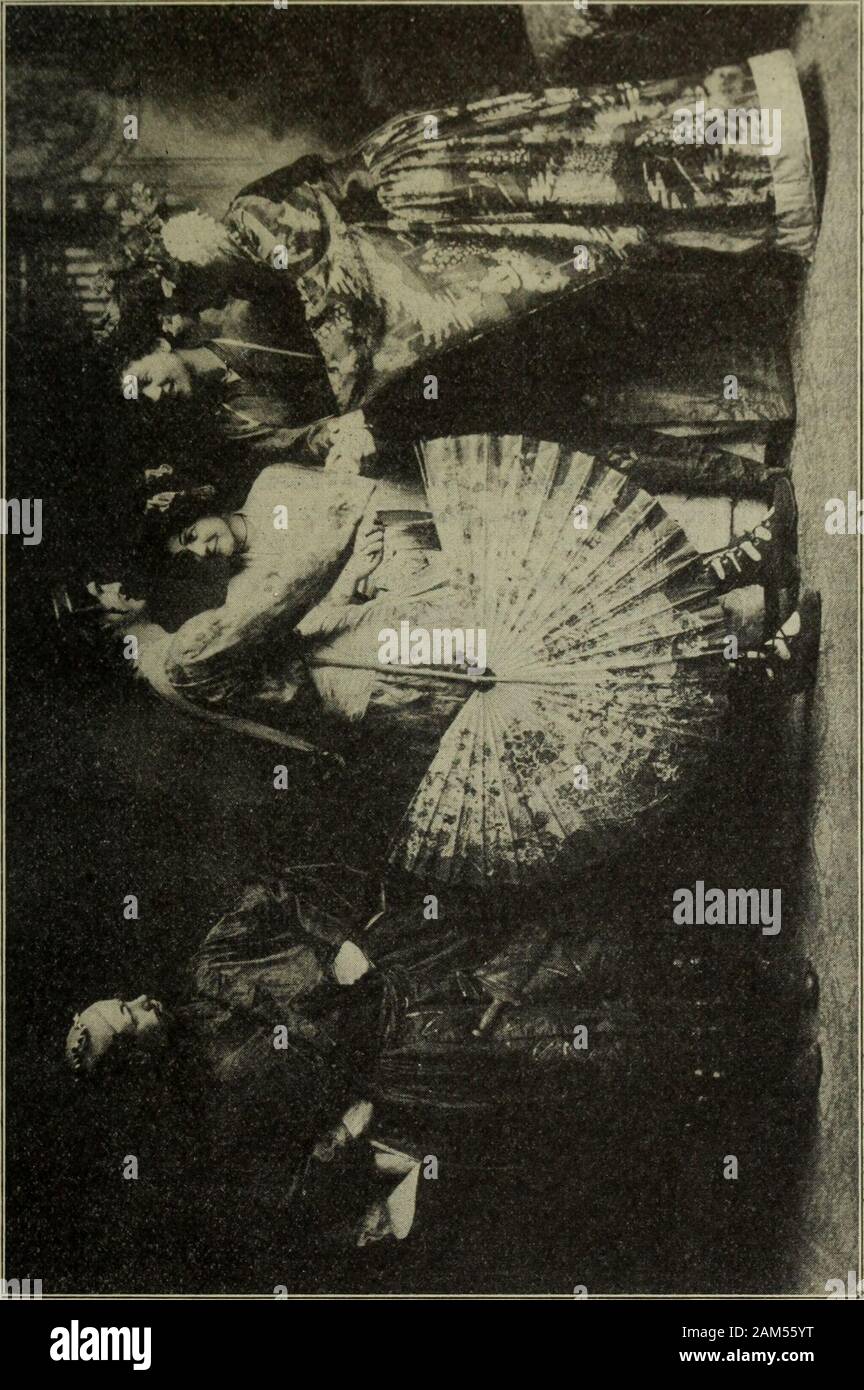 Annual catalogue of the officers and students of the Fort Hays Auxiliary State Normal School : first year--1902-'03 . Hays, Kansas. :;<j. 40 Western Normal School. Course 3.—Cassar, books I and II. Bennetts grammar. The work ofextended translation is begun. A thorough drill in principles of syntax,especially use of cases. Course 4.—Caesar (advanced), books III and IV. The work oftranslation continues. The syntactical study emphasizes the varioususes of the subjunctive mode. Course 5.—Cicero. Four orations against Catiline. In addition to thetranslation, special study of conditional sentence Stock Photohttps://www.alamy.com/image-license-details/?v=1https://www.alamy.com/annual-catalogue-of-the-officers-and-students-of-the-fort-hays-auxiliary-state-normal-school-first-year-1902-03-hays-kansas-ltj-40-western-normal-school-course-3cassar-books-i-and-ii-bennetts-grammar-the-work-ofextended-translation-is-begun-a-thorough-drill-in-principles-of-syntaxespecially-use-of-cases-course-4caesar-advanced-books-iii-and-iv-the-work-oftranslation-continues-the-syntactical-study-emphasizes-the-varioususes-of-the-subjunctive-mode-course-5cicero-four-orations-against-catiline-in-addition-to-thetranslation-special-study-of-conditional-sentence-image339404572.html
Annual catalogue of the officers and students of the Fort Hays Auxiliary State Normal School : first year--1902-'03 . Hays, Kansas. :;<j. 40 Western Normal School. Course 3.—Cassar, books I and II. Bennetts grammar. The work ofextended translation is begun. A thorough drill in principles of syntax,especially use of cases. Course 4.—Caesar (advanced), books III and IV. The work oftranslation continues. The syntactical study emphasizes the varioususes of the subjunctive mode. Course 5.—Cicero. Four orations against Catiline. In addition to thetranslation, special study of conditional sentence Stock Photohttps://www.alamy.com/image-license-details/?v=1https://www.alamy.com/annual-catalogue-of-the-officers-and-students-of-the-fort-hays-auxiliary-state-normal-school-first-year-1902-03-hays-kansas-ltj-40-western-normal-school-course-3cassar-books-i-and-ii-bennetts-grammar-the-work-ofextended-translation-is-begun-a-thorough-drill-in-principles-of-syntaxespecially-use-of-cases-course-4caesar-advanced-books-iii-and-iv-the-work-oftranslation-continues-the-syntactical-study-emphasizes-the-varioususes-of-the-subjunctive-mode-course-5cicero-four-orations-against-catiline-in-addition-to-thetranslation-special-study-of-conditional-sentence-image339404572.htmlRM2AM55YT–Annual catalogue of the officers and students of the Fort Hays Auxiliary State Normal School : first year--1902-'03 . Hays, Kansas. :;<j. 40 Western Normal School. Course 3.—Cassar, books I and II. Bennetts grammar. The work ofextended translation is begun. A thorough drill in principles of syntax,especially use of cases. Course 4.—Caesar (advanced), books III and IV. The work oftranslation continues. The syntactical study emphasizes the varioususes of the subjunctive mode. Course 5.—Cicero. Four orations against Catiline. In addition to thetranslation, special study of conditional sentence
 School dictionary of Greek and Roman antiquities . ACTUARII, short-hand writers, whotook down the speeches in the senate andthe public assemblies. In the debate inthe Roman senate upon the punishment ofthose who had been concerned in the con-spiracy of Catiline, we find the first men-tion of short-hand writers, who were em-ployed by Cicero to take down the speechof Cato. ACTUS, a Roman measure of length,also called actus quadratus, was equal tohalf a jugerum, or 14,400 square Romanfeet. The actus minimus, or simplex, was120 feet long, and four broad, and thereforeequal to 480 square Roman feet Stock Photohttps://www.alamy.com/image-license-details/?v=1https://www.alamy.com/school-dictionary-of-greek-and-roman-antiquities-actuarii-short-hand-writers-whotook-down-the-speeches-in-the-senate-andthe-public-assemblies-in-the-debate-inthe-roman-senate-upon-the-punishment-ofthose-who-had-been-concerned-in-the-con-spiracy-of-catiline-we-find-the-first-men-tion-of-short-hand-writers-who-were-em-ployed-by-cicero-to-take-down-the-speechof-cato-actus-a-roman-measure-of-lengthalso-called-actus-quadratus-was-equal-tohalf-a-jugerum-or-14400-square-romanfeet-the-actus-minimus-or-simplex-was120-feet-long-and-four-broad-and-thereforeequal-to-480-square-roman-feet-image338502561.html
School dictionary of Greek and Roman antiquities . ACTUARII, short-hand writers, whotook down the speeches in the senate andthe public assemblies. In the debate inthe Roman senate upon the punishment ofthose who had been concerned in the con-spiracy of Catiline, we find the first men-tion of short-hand writers, who were em-ployed by Cicero to take down the speechof Cato. ACTUS, a Roman measure of length,also called actus quadratus, was equal tohalf a jugerum, or 14,400 square Romanfeet. The actus minimus, or simplex, was120 feet long, and four broad, and thereforeequal to 480 square Roman feet Stock Photohttps://www.alamy.com/image-license-details/?v=1https://www.alamy.com/school-dictionary-of-greek-and-roman-antiquities-actuarii-short-hand-writers-whotook-down-the-speeches-in-the-senate-andthe-public-assemblies-in-the-debate-inthe-roman-senate-upon-the-punishment-ofthose-who-had-been-concerned-in-the-con-spiracy-of-catiline-we-find-the-first-men-tion-of-short-hand-writers-who-were-em-ployed-by-cicero-to-take-down-the-speechof-cato-actus-a-roman-measure-of-lengthalso-called-actus-quadratus-was-equal-tohalf-a-jugerum-or-14400-square-romanfeet-the-actus-minimus-or-simplex-was120-feet-long-and-four-broad-and-thereforeequal-to-480-square-roman-feet-image338502561.htmlRM2AJM3D5–School dictionary of Greek and Roman antiquities . ACTUARII, short-hand writers, whotook down the speeches in the senate andthe public assemblies. In the debate inthe Roman senate upon the punishment ofthose who had been concerned in the con-spiracy of Catiline, we find the first men-tion of short-hand writers, who were em-ployed by Cicero to take down the speechof Cato. ACTUS, a Roman measure of length,also called actus quadratus, was equal tohalf a jugerum, or 14,400 square Romanfeet. The actus minimus, or simplex, was120 feet long, and four broad, and thereforeequal to 480 square Roman feet
 . Poly, The. A Roman School. Cast of Characters. Teacher Magister Earl Beall Pupils Julius Caesar Arthur Eklund Marcus Tullius Cicero . Alex Guiler Quintus Cicero Bernice Baker Pompay Harriet Avent Brutus ---- Alden Avent Mark Anthony Minnie Anderson Hortensius .Frank Hunter Caecus Minnie Blackstone Catiline ...Harry Bolles Luculus Galdys Dickey Judges Marcus Grassus Wm, Husemeyer Archias Landis Merrill Son of the judge, a student inschool of Rhetoric in Rhodes Gaius Crassus .....Wallace Douglas Tutor Paedogogus . Guy Barnes Slaves Servi 3 philiP wmis blaves bervi j Leonard Niemi —57— Ode to Stock Photohttps://www.alamy.com/image-license-details/?v=1https://www.alamy.com/poly-the-a-roman-school-cast-of-characters-teacher-magister-earl-beall-pupils-julius-caesar-arthur-eklund-marcus-tullius-cicero-alex-guiler-quintus-cicero-bernice-baker-pompay-harriet-avent-brutus-alden-avent-mark-anthony-minnie-anderson-hortensius-frank-hunter-caecus-minnie-blackstone-catiline-harry-bolles-luculus-galdys-dickey-judges-marcus-grassus-wm-husemeyer-archias-landis-merrill-son-of-the-judge-a-student-inschool-of-rhetoric-in-rhodes-gaius-crassus-wallace-douglas-tutor-paedogogus-guy-barnes-slaves-servi-3-philip-wmis-blaves-bervi-j-leonard-niemi-57-ode-to-image336740973.html
. Poly, The. A Roman School. Cast of Characters. Teacher Magister Earl Beall Pupils Julius Caesar Arthur Eklund Marcus Tullius Cicero . Alex Guiler Quintus Cicero Bernice Baker Pompay Harriet Avent Brutus ---- Alden Avent Mark Anthony Minnie Anderson Hortensius .Frank Hunter Caecus Minnie Blackstone Catiline ...Harry Bolles Luculus Galdys Dickey Judges Marcus Grassus Wm, Husemeyer Archias Landis Merrill Son of the judge, a student inschool of Rhetoric in Rhodes Gaius Crassus .....Wallace Douglas Tutor Paedogogus . Guy Barnes Slaves Servi 3 philiP wmis blaves bervi j Leonard Niemi —57— Ode to Stock Photohttps://www.alamy.com/image-license-details/?v=1https://www.alamy.com/poly-the-a-roman-school-cast-of-characters-teacher-magister-earl-beall-pupils-julius-caesar-arthur-eklund-marcus-tullius-cicero-alex-guiler-quintus-cicero-bernice-baker-pompay-harriet-avent-brutus-alden-avent-mark-anthony-minnie-anderson-hortensius-frank-hunter-caecus-minnie-blackstone-catiline-harry-bolles-luculus-galdys-dickey-judges-marcus-grassus-wm-husemeyer-archias-landis-merrill-son-of-the-judge-a-student-inschool-of-rhetoric-in-rhodes-gaius-crassus-wallace-douglas-tutor-paedogogus-guy-barnes-slaves-servi-3-philip-wmis-blaves-bervi-j-leonard-niemi-57-ode-to-image336740973.htmlRM2AFRTF9–. Poly, The. A Roman School. Cast of Characters. Teacher Magister Earl Beall Pupils Julius Caesar Arthur Eklund Marcus Tullius Cicero . Alex Guiler Quintus Cicero Bernice Baker Pompay Harriet Avent Brutus ---- Alden Avent Mark Anthony Minnie Anderson Hortensius .Frank Hunter Caecus Minnie Blackstone Catiline ...Harry Bolles Luculus Galdys Dickey Judges Marcus Grassus Wm, Husemeyer Archias Landis Merrill Son of the judge, a student inschool of Rhetoric in Rhodes Gaius Crassus .....Wallace Douglas Tutor Paedogogus . Guy Barnes Slaves Servi 3 philiP wmis blaves bervi j Leonard Niemi —57— Ode to
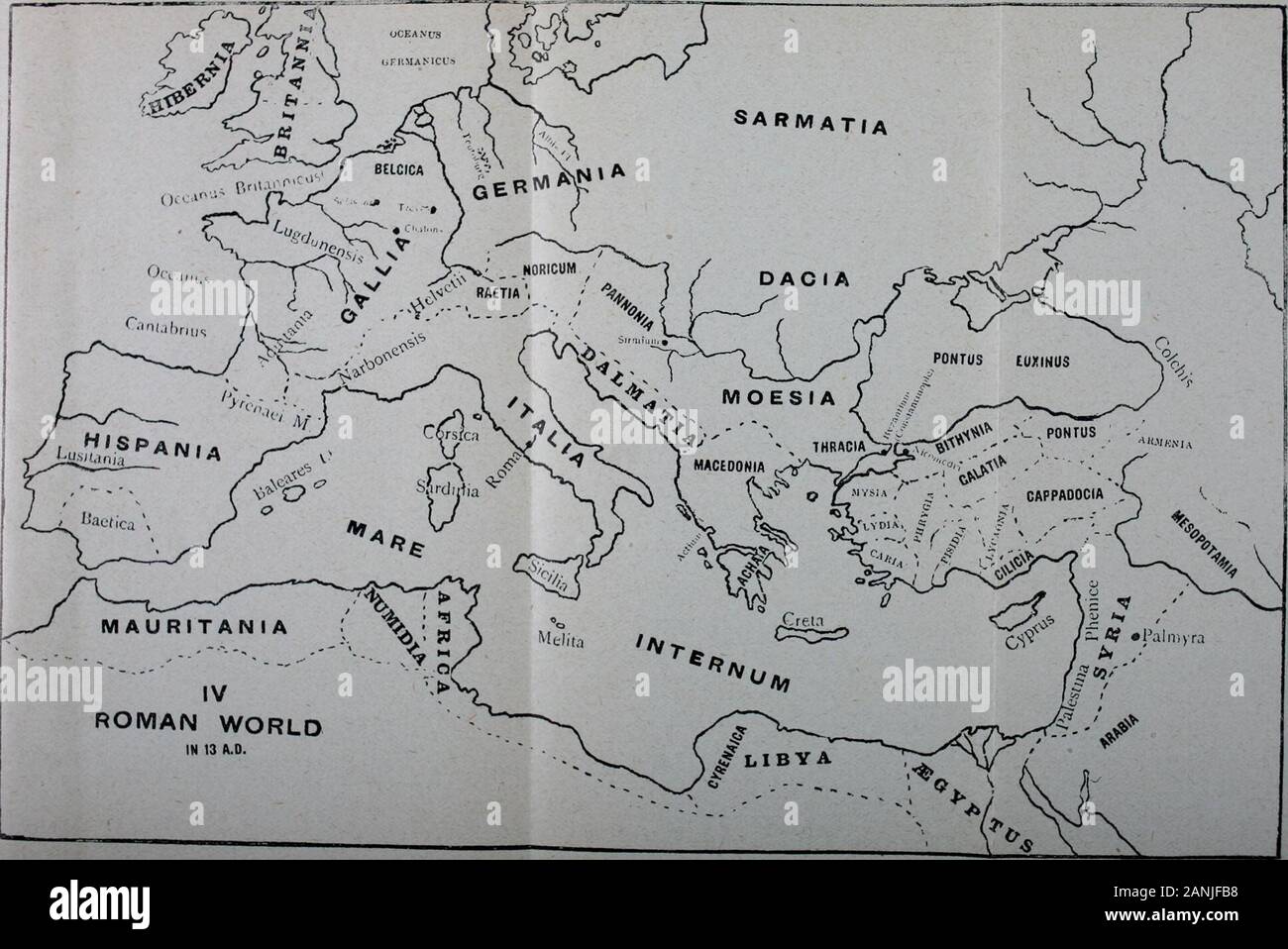 Roman history in brief . ) 2ND Period, Si,—a.d. 14 : (i) Poets : Vergil, 70-19, the greatest epic poetof Rome :—Aeneid, Georgics. Horace, 65-8,the prince of Latin lyric poets: Odes,Satires, Epistles. Ovid, 43—B.C., 18 A.D., the lawyer-poet :—Fasti, Metamorphoses,Tristia, Ex Ponto. (2) Historians: Caesar:—Commentaries, GallicWars, Civil Wars. Sallust, 86-34:—Con-spiracy of Catiline, fugurthine War. Livy,59 B.C.—17 A.D :—Histotyof Rome. Romesgreatest historian. The most perfectspecimen of Latin prose writing. (3) Orators: Cicero, 106-43, chief of Romanorators and philosophers. Orations, Rhe-tori Stock Photohttps://www.alamy.com/image-license-details/?v=1https://www.alamy.com/roman-history-in-brief-2nd-period-siad-14-i-poets-vergil-70-19-the-greatest-epic-poetof-rome-aeneid-georgics-horace-65-8the-prince-of-latin-lyric-poets-odessatires-epistles-ovid-43bc-18-ad-the-lawyer-poet-fasti-metamorphosestristia-ex-ponto-2-historians-caesarcommentaries-gallicwars-civil-wars-sallust-86-34con-spiracy-of-catiline-fugurthine-war-livy59-bc17-ad-histotyof-rome-romesgreatest-historian-the-most-perfectspecimen-of-latin-prose-writing-3-orators-cicero-106-43-chief-of-romanorators-and-philosophers-orations-rhe-tori-image340311980.html
Roman history in brief . ) 2ND Period, Si,—a.d. 14 : (i) Poets : Vergil, 70-19, the greatest epic poetof Rome :—Aeneid, Georgics. Horace, 65-8,the prince of Latin lyric poets: Odes,Satires, Epistles. Ovid, 43—B.C., 18 A.D., the lawyer-poet :—Fasti, Metamorphoses,Tristia, Ex Ponto. (2) Historians: Caesar:—Commentaries, GallicWars, Civil Wars. Sallust, 86-34:—Con-spiracy of Catiline, fugurthine War. Livy,59 B.C.—17 A.D :—Histotyof Rome. Romesgreatest historian. The most perfectspecimen of Latin prose writing. (3) Orators: Cicero, 106-43, chief of Romanorators and philosophers. Orations, Rhe-tori Stock Photohttps://www.alamy.com/image-license-details/?v=1https://www.alamy.com/roman-history-in-brief-2nd-period-siad-14-i-poets-vergil-70-19-the-greatest-epic-poetof-rome-aeneid-georgics-horace-65-8the-prince-of-latin-lyric-poets-odessatires-epistles-ovid-43bc-18-ad-the-lawyer-poet-fasti-metamorphosestristia-ex-ponto-2-historians-caesarcommentaries-gallicwars-civil-wars-sallust-86-34con-spiracy-of-catiline-fugurthine-war-livy59-bc17-ad-histotyof-rome-romesgreatest-historian-the-most-perfectspecimen-of-latin-prose-writing-3-orators-cicero-106-43-chief-of-romanorators-and-philosophers-orations-rhe-tori-image340311980.htmlRM2ANJFB8–Roman history in brief . ) 2ND Period, Si,—a.d. 14 : (i) Poets : Vergil, 70-19, the greatest epic poetof Rome :—Aeneid, Georgics. Horace, 65-8,the prince of Latin lyric poets: Odes,Satires, Epistles. Ovid, 43—B.C., 18 A.D., the lawyer-poet :—Fasti, Metamorphoses,Tristia, Ex Ponto. (2) Historians: Caesar:—Commentaries, GallicWars, Civil Wars. Sallust, 86-34:—Con-spiracy of Catiline, fugurthine War. Livy,59 B.C.—17 A.D :—Histotyof Rome. Romesgreatest historian. The most perfectspecimen of Latin prose writing. (3) Orators: Cicero, 106-43, chief of Romanorators and philosophers. Orations, Rhe-tori
 . Catalogue . ubject rec-ognized by the College Entrance Examination Board andused in designating their examination papers. LATIN The College has adopted the following definitions ofrequirements proposed by the Commission on CollegeEntrance Requirements in Latin. AMOUNT AND RANGE OF READING REQUIRED The Latin reading required of candidates for admissionto College, without regard to the prescription of particularauthors and works, shall be not less in amount than Caesar,Gallic War, i-iv; Cicero, the Orations against Catiline, forthe Manilian Law, and for Archias; Vergil, Mneid, i-vi. The amount Stock Photohttps://www.alamy.com/image-license-details/?v=1https://www.alamy.com/catalogue-ubject-rec-ognized-by-the-college-entrance-examination-board-andused-in-designating-their-examination-papers-latin-the-college-has-adopted-the-following-definitions-ofrequirements-proposed-by-the-commission-on-collegeentrance-requirements-in-latin-amount-and-range-of-reading-required-the-latin-reading-required-of-candidates-for-admissionto-college-without-regard-to-the-prescription-of-particularauthors-and-works-shall-be-not-less-in-amount-than-caesargallic-war-i-iv-cicero-the-orations-against-catiline-forthe-manilian-law-and-for-archias-vergil-mneid-i-vi-the-amount-image370025034.html
. Catalogue . ubject rec-ognized by the College Entrance Examination Board andused in designating their examination papers. LATIN The College has adopted the following definitions ofrequirements proposed by the Commission on CollegeEntrance Requirements in Latin. AMOUNT AND RANGE OF READING REQUIRED The Latin reading required of candidates for admissionto College, without regard to the prescription of particularauthors and works, shall be not less in amount than Caesar,Gallic War, i-iv; Cicero, the Orations against Catiline, forthe Manilian Law, and for Archias; Vergil, Mneid, i-vi. The amount Stock Photohttps://www.alamy.com/image-license-details/?v=1https://www.alamy.com/catalogue-ubject-rec-ognized-by-the-college-entrance-examination-board-andused-in-designating-their-examination-papers-latin-the-college-has-adopted-the-following-definitions-ofrequirements-proposed-by-the-commission-on-collegeentrance-requirements-in-latin-amount-and-range-of-reading-required-the-latin-reading-required-of-candidates-for-admissionto-college-without-regard-to-the-prescription-of-particularauthors-and-works-shall-be-not-less-in-amount-than-caesargallic-war-i-iv-cicero-the-orations-against-catiline-forthe-manilian-law-and-for-archias-vergil-mneid-i-vi-the-amount-image370025034.htmlRM2CE02KP–. Catalogue . ubject rec-ognized by the College Entrance Examination Board andused in designating their examination papers. LATIN The College has adopted the following definitions ofrequirements proposed by the Commission on CollegeEntrance Requirements in Latin. AMOUNT AND RANGE OF READING REQUIRED The Latin reading required of candidates for admissionto College, without regard to the prescription of particularauthors and works, shall be not less in amount than Caesar,Gallic War, i-iv; Cicero, the Orations against Catiline, forthe Manilian Law, and for Archias; Vergil, Mneid, i-vi. The amount